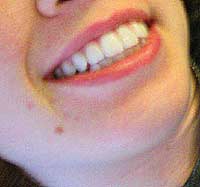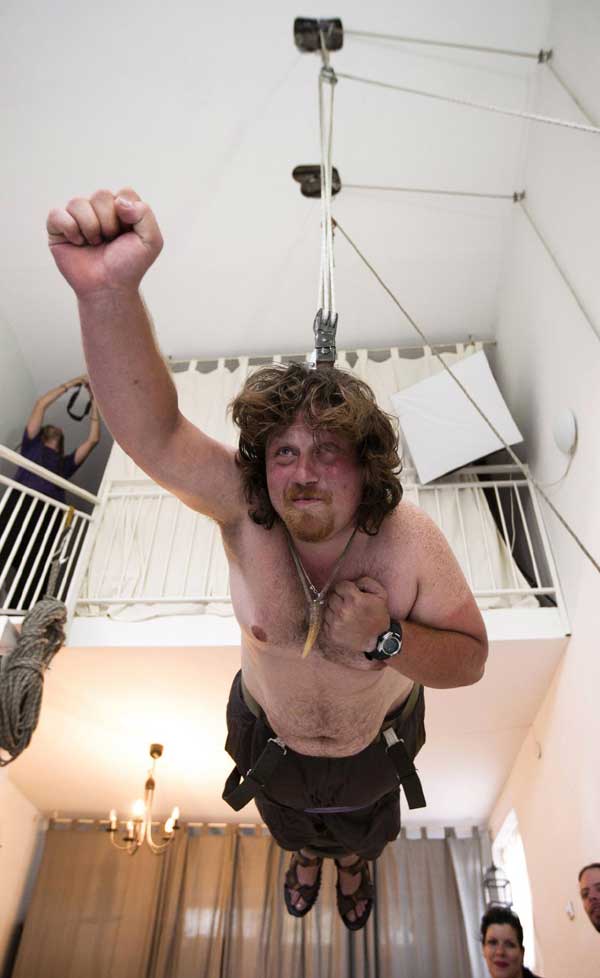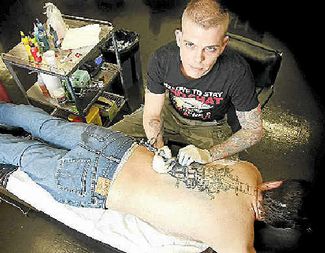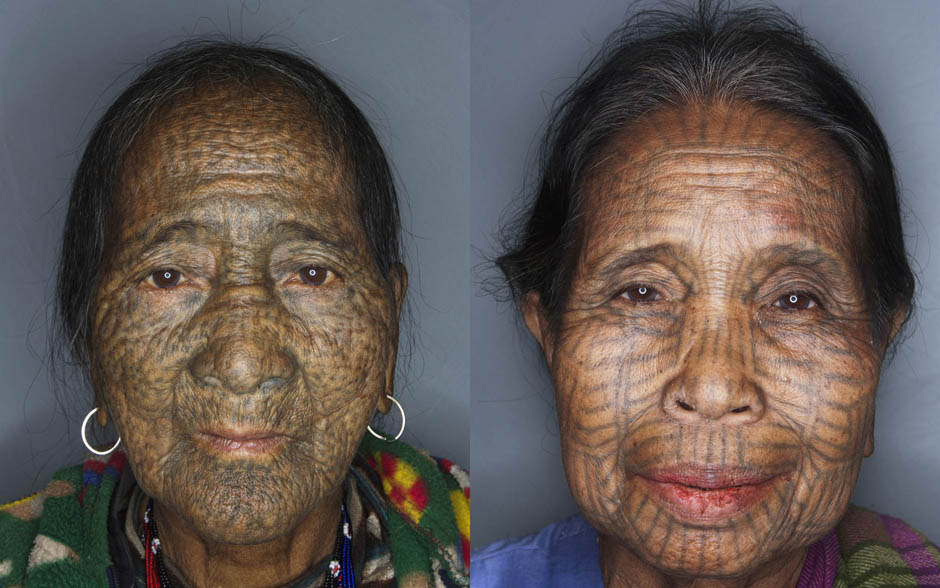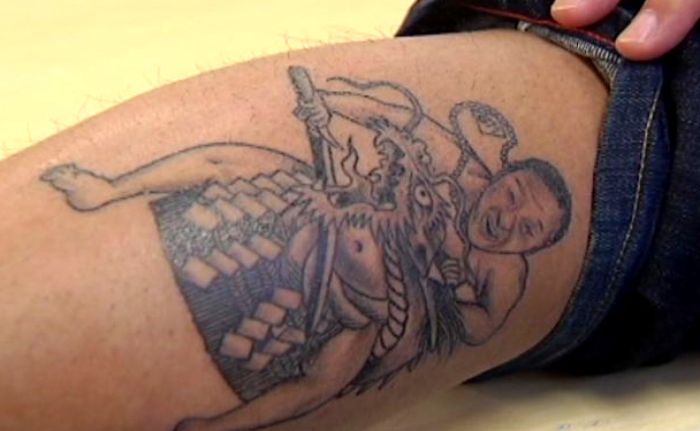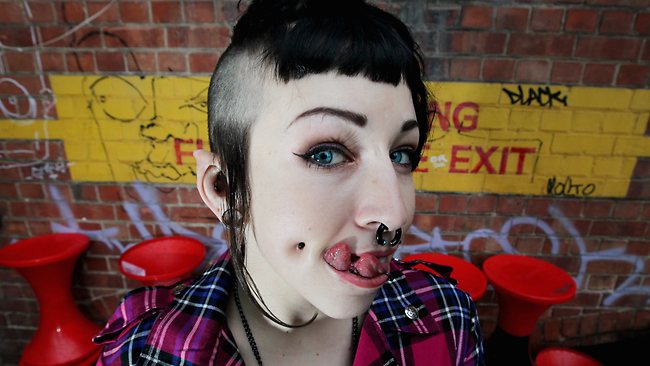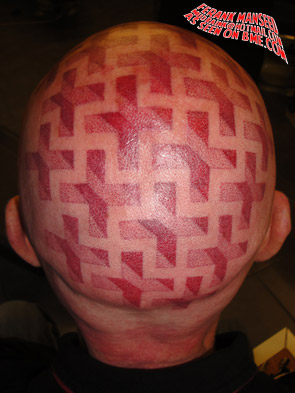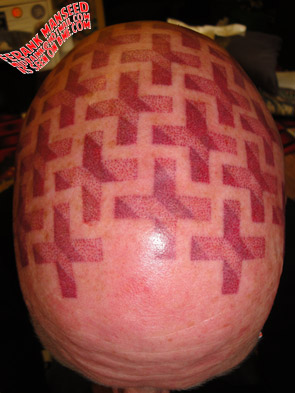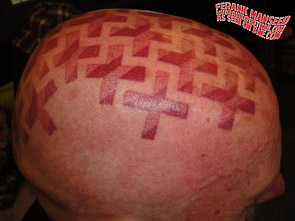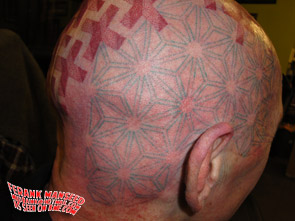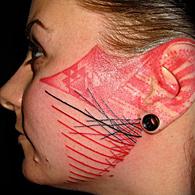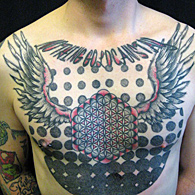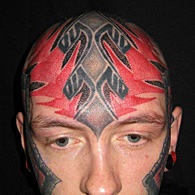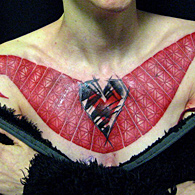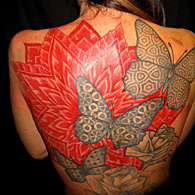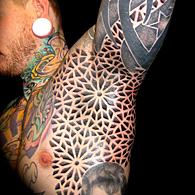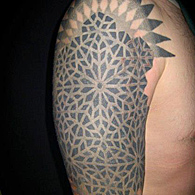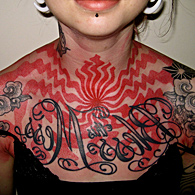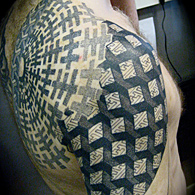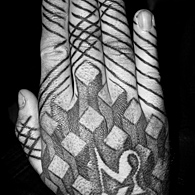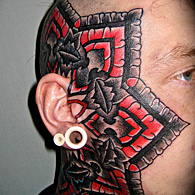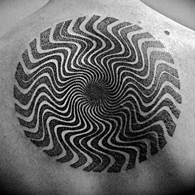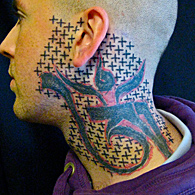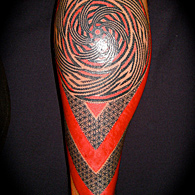
Non-Compete Agreements for Tattoo and Piercing Studios
Non-compete or non-competition agreements are contracts that can be used to protect owners of tattoo shops from unfair competition, particularly in keeping trade secrets and customers. The other way of looking at it is that it restricts artists from tattooing after they have left a studio and puts restraints on making a living. Either way you see it, the bottom line is the bottom line. For studio owners, it can take years of hard work and expense to build up a clientele and strong reputation, and many want to protect that investment. For the artists that work there, it can hold them back from breaking out on their own and being their own boss, or from working and learning from another tattooist. But these non-compete agreements also work in favor for employee artists. If the owners feel protected, then they may be more willing to hire and train others, divulging tricks of the trade to see their employees grow and achieve their own fine reputations. They are less likely to do so if they fear that fine reputation will open shop across the street from them. The fundamental problem of a non-compete agreement arises when it is drafted in a way that is overly broad and restrictive. In such cases, the agreement may not be enforced. Yet, what is deemed fair and enforceable is different from state to state. For example, California has banned covenants not to compete, and only allows those agreements not to compete when business owners sell their businesses to new owners. Colorado and North Dakota also ban non-compete agreements. As for the other states, there are few straight answers – it’s mostly grey shading. There are, however, general criteria that courts will use to determine whether a non-compete clause is enforceable.
How the courts come down on these criteria largely depends on the facts of each case. The courts have found a legitimate business interest to exist where the employer taught the employee special knowledge or skills that could be used once the employee left the business and at the employer’s expense. So, say, the owner of tattoo shop showed her employee tattooist how to make special needle bars, mix colors for special effects, or certain signature shading techniques, the courts could find that the owner had a legitimate interest in protecting her trade secrets, especially because many choose a tattooist based on their techniques and skill and not on marketing ploys and free gifts. An owner’s near permanent relationship with clients could also be deemed a legitimate business interest depending on the length of time, investment, and continuity in that client relationship. Think about how often one hears, “I will only be tattooed by that artist [or studio]” and it is easy to make that connection. Some reputations of employee artists can be enhanced by mere affiliation with a Master Tattooist. Should the Master Tattooist then suffer, without compensation, the loss of his or her clients when an employee banks on the studio’s rep and competes against it? Before you answer, what if you consider that the employee tattooist slaved away for years for the Master Tattooist at a low percentage or salary and then was barred from tattooing in that city for ten years? In deciding whether a non-compete agreement is fair or unreasonably restrictive of an employee’s rights, the main factors for the courts are geographic scope and time. Geographic restrictions must be related to the area where business is being conducted. Yet again, it all depends on what the courts deem a reasonable restriction in light of the facts surrounding the case. One court deemed a limited radius around a business too restrictive while another court upheld a nation-wide restriction. If the agreement prohibits you from tattooing in your city, then the courts may look to whether you work in Manhattan or Back Woods, Wisconsin to determine reasonableness. Reasonableness also factors into time restrictions. One way to determine reasonableness is the amount of time it takes to attract and keep clients. For a machinery maintenance company, a five-year restriction was held to be reasonable but not for an Internet advertising company, where only six months was found to be a fair restriction. Whether non-compete agreements get enforced all comes down to fairness, and, as in most things in life, it involves finding the right balance. Beyond time and geographic scope, courts have found it unfair that an employer only enforced a non-compete agreement with one employee but not others who left before him. Non-compete agreements have also been invalidated when an employee was fired without cause, that is without doing anything wrong, or was not reasonably compensated in exchange for signing the non-compete agreement. There’s also the issue of illegal conduct, where courts have refused to enforce the agreement when an employer engaged in misconduct, so as not to reward to unethical behavior. Thus, if the owner of the tattoo shop is inking minors or engaging in tax fraud, their restrictions on an employee’s right to work elsewhere may be null. In this case, a threat of bringing up the illegality in court may even avoid a law suit all together. Or get your nose broken. The public policy criterion may not be a big issue for tattooists as opposed to, say, doctors. But you may get a progressive judge who will refuse to enforce a non-compete agreement in an effort to stimulate competition in an area and give the public a greater range of artists to chose from, especially so that one does not hold a monopoly over an area. [And finding a progressive judge for your district can just take a trip to the polls for local elections – but that’s a topic for a different article.] After all the criteria have been weighed and it is found that a non-compete agreement is enforceable and that the employee has violated it, what does the employer get? In some cases, lots. The employer tattooist can seek money damages and seek an injunction to stop the ex-employee’s machines from buzzing. If the former employee is working for another studio, that studio may be forced to fire their new tattooist. If the studio does not comply, it may have to pay damages as well. The loss can be great to the employee tattooist who violates a non-compete clause, and because of it, some unscrupulous owners of tattoo studios may try to hold their employees to unreasonable and overly broad agreements even when they know the agreements would not hold up in court. In such cases, particularly when the employers knew the contracts were unfair, the courts have made the employers pay the attorney fees of the wronged employee. [I consider awarding attorney fees to be the judicial equivalent of Karma.] In tattoo Nirvana, there would be no need for lawyers and their hefty fees. The community feeling would persist throughout the ages and all would reap the rewards. If employers did draft contracts they would be fair, and employees would stick to their word and follow them. But true enlightenment is not so difficult, especially if you keep the following things in mind:
Most importantly, in any instance where you are going to draft or sign an agreement that can substantially affect your livelihood, contact a lawyer first. If you cannot afford one, at least do some research and talk to your state labor office (http://www.dol.gov/esa/contacts/state_of.htm) for free. If not, there’s always California. Marisa Kakoulas This article was not intended as legal advice. It is intended for only general information purposes. This article does not create any attorney-client relationship.
|
Search Results for: tattoo learning center
Post navigation
Learning to Smile [Guest Column]

by Samantha K. |
“We do have a zeal for laughter in most situations, give or take a dentist.”- Joseph Heller
I got my teeth whitened for the same reasons I’ve gotten my piercings and tattoos: I like how it looks, I am able to do it, and it’s one step closer to perfection. I strive for excellence in all areas of my life and my body is no exception. I eat well, I make sure to get enough exercise and I adorn myself in ways that I think are attractive and flattering. Being able is about acknowledging and exerting my control and ownership over my body. Whereas my suspensions have been about what it can do, external adornment is about what I can do to it. When people ask “Why can’t you be happy the way you are?” I say “Why should I have to be? Why should I settle when I’m capable of more? Why not control my own body’s destiny?”
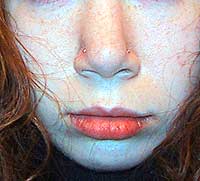 Before
|
When I was in elementary school, I, like many others my age, had to get braces. Or rather, looked forward to the idea of braces up until they started to go on, at which point I started what would become five years of sheer torture and misery. My orthodontist was a liar who promised that I would have braces for a couple years and then wear a retainer for a bit and all would be fine. In actuality, I had big ugly silver braces for a couple years, then a retainer, after which I was told that my teeth hadn’t actually finished settling because they put the braces on too early and I’d need them again. The braces went back on for a few years. I felt betrayed by the dentist whom I’d trusted and questioned her every visit as to when I’d finally be free of the metal shackles. She stopped giving me even vague dates, so I started throwing tantrums and begging the braces to be taken off. Eventually, my parents gave in, signed paperwork saying that we understood they were coming off early and that my teeth would suffer as a result and that the orthodontist was no longer liable for anything. At that time, I didn’t care about what my smile would look like and was just glad to be done with the whole thing.
As soon as the braces were off and I got a good look at my teeth, I became self conscious. They were big and slightly crooked and I still had a definite overbite. In addition to all that, there were big white spots where some of the braces had been glued. Many of my pictures from that time show me with a close lipped smile or one that had been carefully controlled to show only a certain amount of my teeth. Whenever I smiled freely, I looked back later and cringed at how awful I looked.
Even though I’d never had any cavities and dutifully brushed twice a day, my teeth were never very white. Maybe it was from all the chocolate I ate, or the iced mochas which became a staple of my diet, but over the years they’ve developed an increasingly yellowish tinge. I tried the Whitestrips one can buy at the drugstore, but they only magnified the problem. They go over the front few teeth, so while those teeth became fairly white, the sides only looked worse in comparison.
I’d heard about something called Britesmile a few times, but didn’t know anyone who’d done it. It’s a one hour procedure that can be done at either the Britesmile spas or in a dentist’s office. They apply a special gel to your teeth and shine a UV light on it, taking off the gel and reapplying every twenty minutes. It’s supposed to whiten your teeth nine shades, on average. When I checked into both, the cost seemed to be about the same for that and the custom bleaching trays that you get at the dentist.
During a recent dental checkup, my hygienist commented on the disparity in color between my front and side teeth. Hearing about it while lying on my back in that chair was pretty embarrassing and made me wonder why I hadn’t done anything about it yet. I was ashamed that I had been letting my teeth control me instead of doing something about it. The hygienist showed me a simulation of what my teeth would look like after Britesmile and I immediately decided I’d do it as soon as possible. I was immediately excited, thinking about the blindingly white smile I’d soon have.
I called up for an appointment and could have gotten one the same day, but decided to wait till that Friday when I would have nothing to do after in case I was in pain. I chose to do it at the Britesmile spa rather than at the dentist’s office because it was cheaper and they did it all do so I figured they’d be less likely to make mistakes. It also ended up being a much more relaxing environment; with a very modern décor and flat screen TVs mounted above all the chairs.
The first thing I did was fill out a form with various dental and medical history information and names of my emergency contacts. After that and reading through the fine print of all worst case scenarios, my excitement turned into a little bit of fear and wondering if I’d made the right choice. I looked up, saw the white teeth of all the receptionists and realized that I wanted it much more than I was afraid of it, which is what it always comes down to for me. I gave them the form and was led into a small room by the resident dentist. She went over my forms, saw that I had an average sensitivity to hot and cold, and gave me some Tylenol to take before we started. I asked for clarification about aftercare and the dentist made it clear that I did indeed have to eat only white and clear foods for the next 24 hours. After the whitening the normal coating on your teeth isn’t there, so if you have anything colored during that time, it will stain your teeth. I got a little more nervous when she mentioned the possibility of something she called “zingers” — extreme sensitivity in some teeth leading nerves to fire randomly and sharply for the next day or so — and said that I would be more prone to that because of my age. All that aside, I was still eager to get started.
First I went and brushed my teeth and then one of the assistants came in to take a before picture. After that, she placed a dental retractor in my mouth to keep it open and some padding behind it so it wouldn’t hurt my gums. Then she applied a gel to my gums to protect them from the laser. I suddenly felt wet above and below my lips and realized that there was some kind of goop there which was used to keep the paper around my mouth in place (without that I would have ended up with a really strange looking tan from the light). That ended up being the most unpleasant part of the whole experience. It only took a few minutes before I’d adjusted to all the stuff in my mouth and felt pretty relaxed.
The dentist then came back in to finish setting things up. She gave me glasses to protect my eyes and attached a call button to the waistband of my pants. Since I was lying down and completely unable to speak, this was really comforting. I had my ipod on, but decided I might also want to flip through some TV, so she gave me the remote and headphones for that too just in case. She then painted the gel onto my teeth, put the light in place, and said she’d be back in twenty minutes. The time went pretty quickly and I didn’t feel any tingling or sensitivity. I relaxed and listened to some disco while watching cheesy soap operas. After two more sets of twenty minutes, the dentist said that she was going to do a 4th run, since my teeth had started off so dark. Twenty minutes later, all the stuff was out of my mouth and I was once again brushing (and wiping goop off my face). I was in shock when I saw how white my teeth were. They’d gone from shade D1 to A2 (one shade below the whitest on the chart, and whiter than they’d labeled it in my after photo). An “after” photo was taken and soon I was back in the waiting room buying some mouthwash and toothpaste.
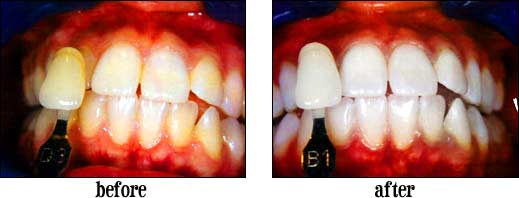
I left the office beaming and I continued to smile throughout the two mile walk back to my apartment. I couldn’t believe how wonderful I looked and felt. Friends and family who saw me later said that it was a larger change than they’d expected, and that it made more of a difference when they looked at me than they’d expected. It was one of the best things I’ve ever done for myself and the feelings I had were similar to the feelings after a suspension: elation, supreme confidence in my body, and joy that I had the experience.
It’s been six days now and I’m still immensely pleased with my decision. I smile more than I have in years and am no longer hesitant to take pictures; I simply smile without wondering how my teeth will look in the picture. I finished the experience with a new school ID card featuring a big happy grin. While no ID pictures are ever great, at least this one matches my mental image of myself.
Samantha K.

Samantha K. (iam:joy) is a student of physics, art, and life. When she’s not publishing undergraduate science research, she is busy knitting. Samantha can usually be found on the streets of New York with her very ferocious little dog. If you enjoyed this article, reward her with a book.
Online presentation copyright © 2004 Samantha K., and BMEzine.com LLC. Requests to republish must be confirmed in writing. For bibliographical purposes this article was first published online September 1st, 2004 by BMEzine.com LLC in Toronto, Ontario, Canada.
ModBlog News of the Week: July 15th, 2011
By now the weekend will have started for many of us on the east coast, while the west is not far behind. Granted in Australia it’s already the future so they’ve already got a head start. This week’s news is fairly concise, with a couple of updates on past stories, as well as a look into the facial tattoos of Burma’s Chin province.
First up is more on TLC’s “Tattoo School”. Last night the program aired, and news agencies all over have started to notice the overwhelming negative feedback coming from the tattoo community. What surprised me the most is that every story I read is falling on the side of the tattoo artists, and joining in the condemnation of this show. This first article from the Jamestown, NY Post-Journal where they talk to artists in the area around the school, as well as former students of a tattoo school.
Ryan Gillikin has been in the tattoo industry for more than 20 years. Tattooing is a tradition, he says, and the only proper way to learn the skill – and to learn to administer the body art safely – is to be under the guiding hand of a master tattooist in an apprenticeship. ”My apprenticeship was a year,” said Gillikin, owner of Almighty Studios Tattoo and Body Piercing in Jamestown. ”And when I apprentice (others), it’s a two-year process.” Gillikin said there are several such high-profile tattoo schools around the nation, and that each has the same motive – to scam people out of money and to make them believe they are talented tattoo artists when they are not.
A haircut from an untalented beautician will grow back, however. A tattoo from an untalented artist could land someone in the hospital with an infection or a disease, Gillikin said. And he fears that people who open shops based on what they learn in tattoo schools are coming out without knowing how to stop that from happening. ”You can’t even learn the basics of sterile practices in two weeks,” Gillikin said. ”So when people take $5,000 from somebody and tell them they’re going to be professionals in two weeks, they’re just giving people a false idea that they know what they’re actually doing.”
Now over to The Examiner which takes a look at the what the community is doing to protest this show.
It’s completely impossible to be a professional tattooer in 14 days, at least not one who has been properly trained to produce quality work using safe sterile practices. Can an aspiring doctor become prepared for surgery in 2 weeks? Of course not. Professional tattooers pride themselves in being knowledgeable about the prevention of disease transmission and giving their clients a clean tattoo in a clean environment. Photos on the Tattoo Learning Center’s website show students tattooing without using standard protocols such as wrapping their machines and clip cord with plastic wrap. This is an easy way for cross contamination of blood and body fluids to occur. A second photo shows a student tattooing someone on a wooden stool, material that can not be cleaned or disinfected properly. Definitely a health code violation.
Tattoo artists and enthusiasts are uniting online through Facebook pages, Artists and collectors against TLC’s “Tattoo School” and Boycott TLC’s Tattoo School Show. Both pages have a combined total of over 45,000 fans and the number is growing by the minute. The anger being shown regarding the upcoming show has nothing to with fear of new competition but everything to do with fear of one’s livelihood being disrupted. If the tattoo school fails to educate their students about safe tattooing; diseases and infections can be spread.
Finally, a group of protesters formed outside the San Diego branch of the “school”, where they learned some new information about how they run their business.
Local tattoo artists are protesting a new school in Pacific Beach that plans to teach people the art of tattooing in two weeks. The group stood outside the Steady Flow Tattoo shop, also known as the Tattoo Learning Center, at Grand Avenue on Monday, protesting what they believe is an insult to their profession. “These people are teaching people how to tattoo for a lump sum of $5000, and within two weeks, they are supposedly professional tattoo artists,” said Randy Janson, a tattoo artist. “It’s not really possible. It is more of a scam.”
One of the school’s students and two women interested in getting a tattoo at the shop watched the group with a bit of concern. The student said he flew to San Diego from out of the country and was told when he arrived that his two-week class was canceled. The man, who wishes to remain anonymous, said the school told him to enjoy his free accommodations and that his tuition would be refunded. He said the shop owner told him to drive by the storefront to check it out and stumbled on the crowd growing outside the shop.
The student said he is already a tattoo artist in his home country, but he had hoped to come to the United States to become a licensed tattoo artist. In San Diego, you only need to fill out an application and pay the appropriate fee to be able to practice tattooing within the county limits, according to the County of San Diego’s Department of Environmental Health’s website.
Two young women interested in getting tattooed were also standing outside the shop amidst the protesters. They said they spoke to someone at the shop earlier in the week and were told they don’t take appointments; rather, they should simply stop by. When the girls arrived, they found the shop closed. After a second phone call to the shop, they learned Steady Flow would be closed for two weeks.
So not only does the school cancel classes at the last minute, it also doesn’t take appointments, which isn’t surprising as it seems to close on a whim when there aren’t students there to ruin someone’s skin. Following the links above will get you information on how to contact TLC and let them know how dangerous this show is, as well as links to online petitions. Some groups are encouraging people not to buy any products advertised on the show, as well as encouraging tattoo studios to contact suppliers and inform them that as long as their products are used on the show, they won’t be getting orders. What this comes down to is money. If TLC isn’t making any money off the show it will be cancelled. Hopefully that happens sooner rather than later.
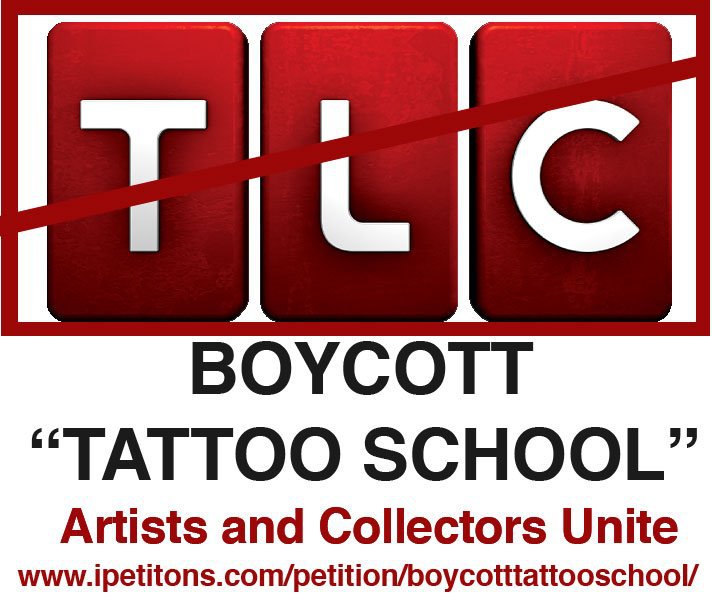
More news to come, so keep on reading.
This next story is from my hometown of Toronto, ON. Two body piercing shops have been found not using proper infection controls, and Toronto Public Health is encouraging anyone who was pierced there to contact them.
The shops are NY NY Body Piercing, located at 1700 Wilson Ave., Unit 151, and New York New York (Accessories & Body Piercing), located at 423 Queen St. West. Anyone who received a piercing from the stores between Nov. 6, 2010 and March 1, 2011 should visit a doctor and ask to be tested for hepatitis B and C and for HIV, the public health authority said.
New York, New York has four shops in Toronto. Only the two listed above were part of the Toronto Public Health investigation. Piercing and tattoo equipment should be sterile and sterilizers should be tested every two weeks to ensure they are working properly, the public health authority said. Toronto Public Health recommended piercing and tattoo clients always check to ensure employees wash their hands, change gloves, use an antiseptic on the skin, and open sterilized packages of equipment for every client.
In somewhat disturbing news, I was informed that the queen street location is still open for business. Previously when a shop has been flagged by Public Health, they were forced to remain closed for the duration of the investigation. As such I’d encourage anyone in the city to avoid these studios until they’re cleared by the health board.
While on the subject of possible infections, scares like this have caused a German football club to ban players from getting tattooed.
Werder’s decision to scratch their players from getting anymore tattoos is a result of the infection that forced Hamburg SV’s Eljero Elia into a lengthy and painful injury break in March 2010. “It is a risk that we need to rule out,” the German club’s sports director Klaus Allofs told the Hamburger Abendblatt newspaper. Several Werder players are fans of tattoos with Austrian Marko Arnautovic sporting several.
Moving away from tattoos for a moment, the Tel Aviv suscon was featured on China Daily. Not necessarily the first place I’d look for suspension news from Israel, but with local suspensions starting to take place in China we may be hearing more news from them in the coming months.
A man is suspended on hooks pierced through his skin at a suspension convention in Tel Aviv July 9, 2011. Some 30 people attended the convention, which offered the chance to be suspended or just watch. Captain Howdy, who organised the event, said the origin of the practice comes from Native American cultures that used to perform body suspensions as a rite of passage. He said the practice has been revived by people prepared to test the limits of mind over matter.
Heading back into tattoo news, according to AOL’s finance section, tattoos seem to be a recession proof industry.
New’s experience is not unusual. According to Time magazine, roughly 16% of people with tattoos eventually elect to have them removed. And that number is growing. Which isn’t necessarily surprising. Sometimes, the love of our life, whose name we permanently inked across our bicep, turns out to be a fling. Or that image of the Tasmanian Devil that looked so cool after a night of drinking is a little less appealing in the sober light of day.
Additionally, in today’s challenging economy, when unemployment continues to hover near 9%, people are also choosing to remove tattoos to appeal to potential employers. At least, that’s half of the story. At the same time, others see the recession as an opportune moment to get inked, arguing that it’s not only a relatively cheap splurge, but that the unemployed no longer have to conform to an employer’s standards.
In either case, the end result is the same: The tattoo industry continues to thrive, seemingly recession-proof. To better understand this strange dynamic, I visited Tattoo Lou’s, a family-owned chain of Long Island tattoo parlors that also offers laser tattoo removal.
Well, it seems that one studio is doing well, can the same be said for the ones in your area? Let us know in the comments below.
Now if you remember back to last year, there was a story about an Australian man who paid an acquaintance to tattoo him shortly after having a fight with him. What was supposed to be a yin-yang turned out to be something quite different.
AN IPSWICH man is enduring a series of painful sessions to cover up a lewd image tattooed on his back by a backyard operator. Matthew Francis Brady, 22, has admitted tattooing a 40cm-long image of a penis and a crude slogan on his former mate’s back. The victim had wanted a Yin and Yang design with some dragons but was horrified with the end result.
Upon hearing about the case, Ipswich business Ultimate Image Tattoo offered to do the cover-up work for free. The 26-year-old victim this week had his third appointment in a long series of visits to hide the offensive tattoo. Brady pleading guilty in Ipswich Magistrates Court last month to assault occasioning bodily harm while armed and assault occasioning bodily harm. He will be sentenced later this year.
After several more sessions the man will be able to proudly display a much more professional tattoo of a sword with a dragon wrapped around it. The sessions last for up to an hour – or however long the man can stand the pain. Tattoo artist Matty Tredgold said the final work would include a range of colours from blue, green, yellow and red and was inspired by one of the client’s favourite T-shirts.
I think my favorite part of the original story is the man who did the tattoo told him to keep it covered and not show anyone for 2 months. Thankfully he got someone to take a look at it right away.
Today’s final story comes to us from The National Post, about the women of Burma’s Chin province. While the custom of full facial tattoos on women is pretty much extinct, there are still some women who were born when the practice was being followed. It’s a great read that takes a look into a cultural ritual that may become completely extinct in our lifetime.
To many of us here in the West, it would be pretty unheard of for a woman to tattoo her entire face. But these women have been doing it for hundreds of years. Why?
When I asked, I got varying responses. But the consensus seemed to be that a long time ago they were known for their beauty, and kings in Burma found out about these Chin women and teenagers. The kings would then come and basically pick out the women he wanted and take them away. In response to that, the village elders who were women started tattooing the girls as a measure against the king coming to take them away. It was almost to steal their beauty.How did the practice become more commonplace?
Although it was once something to make them ugly, over time these women have become to view themselves as beautiful. It came to be a symbol of strength, of beauty, of toughness. Some of the women even said to me “If I didn’t have this tattoo, men wouldn’t want to marry me.” It’s definitely a rite of passage in these villages. And it’s really really painful.
That’s all the news we’ve got this week. Have a great weekend, and as always, if you find a story you think should be included in the news round-up, just click here to send me the link, or simply send me an e-mail.
ModBlog News of the Week: July 9th, 2011
Thanks to some ISP issues this week will be a “better late than never” edition.
Thanks to the wonders of social media, my inbox and facebook wall have been slammed with links about this first story. Justifiably so, as it has the potential to affect not only the community, but also anyone interested in getting tattooed in the future. I honestly wish I was using hyperbole there, but in reality, this actually can have a big impact on the tattooing industry. I’m sure by now you know what I’m talking about, but if you haven’t heard yet, TLC is planning on airing a new series starting next week called “Tattoo School”. The show’s description reads:
Award-winning Tattoo Artist Lisa Fasulo runs a hands-on and unconventional tattoo school in upstate NY where students from all walks of life learn how to tattoo in just two weeks. These rookie students are seeking to change their lives through tattooing. With just two intense weeks under Lisa’s instruction, they will get the experience tattooing on body after body with artwork of varying levels of difficulty. Rookie students, models risking their skin to first time body artists, a rebellious instructor and unconventional training…who will bear the drama of competition and survive?
So according to them anyone can pick up a machine and learn to tattoo in 2 weeks. It also looks like they’re stepping up the “drama” to make good TV by adding some kind of competition factor. Who can last the full 2 weeks? As if 2 weeks is somehow a long time to learn to tattoo. It’s this point here that most people have a problem with. TLC’s programming has been consistently portraying the tattoo industry as a drama filled joke where legitimate artists are used as pawns in a scripted soap opera, with the work taking a back seat. On top of that this new show will give viewers the impression that anyone can learn to tattoo in a couple of weeks.
This isn’t about having to “pay your dues” or doing bitch work at a shop in order to earn your apprenticeship, this is about taking a legitimate trade/artform and misinforming people about it. Learning to tattoo takes a long time, months to years. Learning to tattoo well takes a lot longer.
Putting that aside for the moment, lets take a look at the larger ramifications of this television series and the school it is promoting. A large number of studios won’t take an artist who only has 2 weeks of experience, this means that the graduates from this program will be forced to find other ways to continue to tattoo, which inevitably will lead to tattooing out of their home. I don’t think I need to explain anything beyond that. As for the show, it will give people the idea that all it takes is a machine and a few hours of practice to know what to do. With the availability of machines on e-bay, as well as those “tattoo starter kits”, there could be an increase of the number of people who think “well if they can learn everything in 2 weeks, it must be easy”. They then go out, get a kit, and start working from home. Taking a look at the school’s website, here is what students will be receiving for their almost 5 thousand dollar tuition:
What does the tuition include?
* A professional tattoo machine.
* 80 Hours of tattoo instruction with certified, experienced, award winning, tattoo instructors.
* FREE lodging for 2 weeks.
* Dozens of willing, prescreened human models for you to learn and practice on.
* Use of all our equipment at our State of the Art tattoo training facilities.
* Informational binder with all the important contacts and sources for all things “tattoo related”.
* DVD of machine tuning produced by the TLC staff.
* Tattoo techniques textbook
* Tattoo License permit (as per county)
* Certificate of Completion upon course graduation.
* Tattoo Learning Center T-Shirt.
* Transportation to and from the student housing daily.
* DVD with digital pictures of all the tattoos you completed while at school (enough for a beginning portfolio).
*** LOTS and LOTS of nurturing and emotional support that makes us the finest tattoo school!
You’d think that if they wanted to be a responsible school, they’d include an autoclave with tuition. Reading through her blog post on hate mail, it seems that Lisa believes that people find this to be a bad idea simply because you need to “pay your dues”. While that may have been the case in the past, nowadays apprentices focus mainly on the art and technique. Sure there are a lot of people who stick to the old school methods, but that isn’t why people are opposed to this type of “school”. What she doesn’t seem to understand is that tattooing is an artform, one that takes years to master, and to convince people that it only takes 2 weeks to teach someone is doing a disservice to the students and the profession. It’s also highly irresponsible, and only serves to create more and more scratchers, giving legitimate artists a bad name. With tattooing as popular as it is now, local governments are starting to pay more attention to studios, which isn’t a bad thing as most studios welcome strict health code regulations, but when the politicians hear about artists in basements spreading diseases, then you end up with studios being forced to close down because of new zoning laws preventing studios from operating.
Of course, this has caught the attention of a number of different people. A quick google search reveals a number of studios and publications getting on board, encouraging people not to watch the program. There is a facebook event page, a boycott page, as well as an online petition (feel free to skip the donate page). A number of people have also taken to using this image as their facebook profile photo:

While not watching the program is a good start, Alie K (IAM: alouicious) had this to say with regards to the program:
Been seeing a lot of people changing their avatars to the ‘boycott tlc logo’. Hey, it’s great that you are unhappy about a network’s decision to produce a show that won’t do much except give people false hopes about being the ‘next Kat Von D’, but complaining about it won’t do much except make you look like a whiner.
Instead of having a black cloud looming over your head, do something PROACTIVE about it. Unhappy with TLC’s decision? CONTACT THEM! They have an ethics hotline where you can actually phone them and give them what for (though you may want to have something pre-written to follow so that you don’t fly off the handle and sound like an jabbering idiot – which of course, you are not). They also have a viewer relations link where you can type them a letter and let them know your displeasure.
Instead of typing things like, “YOUR NEW SHOW IS STUPID AND IS TAKING BUSINESS AWAY FROM ME! YOU’RE AN ASSHOLE FOR PRODUCING IT!”, which won’t do that much except maybe make someone on the other end say, “Heh heh – looks like we pissed off another one”, consider writing about what makes the tattoo industry what it is and why you feel that advertising about a school will give an individual a false sense of “yeah I can do that! Look how easy it is! A real apprenticeship takes too much time. I can’t be bothered with that”. We all know that tattooing isn’t easy in the least.
We’ve all seen tattoos done by ‘some dude in his basement’. Some of us have been asked to cover them up with a ‘real’ tattoo. Sending a ‘newly schooled’ person out into the wild with their ‘new gun so they can start tattin’ people up’ will only result in people tattooing out of their homes (because they aren’t talented enough to get into a real shop) and potentially causing outbreaks of staph infections and worse, because these individuals are unable or unwilling to get the proper supplies to protect themselves and their clients (a dental bib is about the same as a paper towel, right?).
Perhaps we should focus our emails on health and safety issues as well as terrible tattoos that people will be complaining about the cost to cover up or laser off a few years down the line. In the mean time, REAL artists should focus on self-promotion and marketing to make themselves stand out above the sub-par, lazy, tattoo school artists. Either that, or get REALLY GOOD at doing coverups.
Courtesy of Lorin Hay:
If anyone would like to call and leave Lisa Fasulo a message of support in her new TLC Tattoo School project, her number is **1-800-466-4117 **. Show her some love!! Especially since she has blocked her Facebook account from receiving any friends request or messages, and has removed her Twitter account. Another number you can use is 518-428-4271. The listed email addresses for her are [email protected] and [email protected] and The address of the school is 1301 CURRY ROAD ROTTERDAM NY 12306
Sample emails:
Courtesy of Chris Collins:
Please do not air the Tattoo School show. It is irresponsible to let people think that just because some states have lacking heath code enforcement and education requirements that it is okay to do something as potentially dangerous as tattoo the public as an amateur. That show is a time bomb waiting for lawsuit and further more just dangerous to let the public think it’s as simple as a few hours “education” and then you are okay to to practice a somewhat invasive procedure. Please pull the plug on this.
To get in contact with TLC directly, you can find their phone contact information here: http://corporate.discovery.com/contact/ethics-hotline/ it has the contact phone number for all the countries that air TLC programming. The US and Canada number is 1-800-398-6395. You can also send in a written complaint via this page: http://corporate.discovery.com/contact/viewer-relations/.
As I said earlier, this program is angering a large portion of the community. While complaining on facebook is one thing, if you feel this does affect you negatively in some way, or you think that it is irresponsible programming, get in touch with TLC directly and let them know. Contacting advertisers is also a way to send a message to TLC, for without advertising a program can’t stay on the air.
I’ve dedicated a big chunk of today’s news to one story already, but there is more news this week. Keep on reading to see the rest of this week’s news.
Now in another story that ties into the today’s lead story, police in Newport, RI have issued a citation against an 18 year old tattoo artist. It turns out that you need a license to tattoo in Newport. Oh and that you shouldn’t set up shop in the middle of a park.
Julian Rodrigo, 18, of 195 Admiral Kalbfus Road, Newport, was issued a court summons on Saturday for illegally tattooing minors and not having a tattoo parlor license.
As part of a follow-up, police met with a the mother of a 16-year-old who Rodrigo tattooed. According to reports, she was upset because her son was able to get tattoos without her consent. She said Rodrigo was giving tattoos to juveniles in the Rolling Green area and was not licensed or trained.
Police spoke with Rodrigo, who said he did not know he needed a license, and that he had bought the equipment online. Officers came to an agreement with the reporting party that since Rodrigo had no prior criminal history and was unaware of the law that required him to have a license, to only issue him a citation.
Maybe Julian should have taken a 2 week course after buying his kit online. Then again, not too many studios would hire an artist with 2 weeks experience and a machine bought online, so he probably would have ended up in the park anyway.
Another story that’s been hitting the social media feeds is an “interactive tattoo“. Originally this was streamed online, but thanks to the wonders of video editing, there’s a shortened version available. The idea behind it, is that with a QR code, an iPhone, a design company, and a corporate sponsor, you can get a tattoo that when viewed using a specific app, will animate the tattoo.
As part of whisky brand Ballantine’s “Leave an Impression” campaign, Paris-based tattoo artist Karl Marc seared a QR code onto his friend Marco’s chest. Marc says the whisky company approached him and asked if he would be interested in executing the tattoo — a QR code that unlocked an animation when scanned — via a live stream on the brand’s Facebook Page. The brand is doing similar events with other artists, from ice sculptors to graffiti artists. “The video was made during four hours, all live, with no breaks or interruptions,” Marc says. “I had a camera strapped to my head as well as microphones and battery packs. We didn’t know if the Matrix code would actually work right up to the very end. It worked on paper, but would it work as a tattoo?”
You’re probably wondering if the tat is fake — after all, that Facebook friend tattoo turned out to be an advertising campaign, as did the Ray-Ban tattoo. But Marc says that the ink is the real deal. And it does seems likely. There’s no hidden viral agenda here: Ballantine’s hosted the live stream of the process on its brand page. Marc says he’s been getting a lot of requests lately for QR code tats, and he told us that he will be working with a company called MIYU productions on more ink of this ilk. Marc provided us with Marco’s design. You can scan it to check out the animation that currently graces Marco’s body. Use ScanLife to access the video.
As cool as this is. All I could think about at the end of the video was that he just put his phone on top of a fresh tattoo barehanded, and that he was typing on the keyboard without changing gloves from the machine.
Just a couple more quick tattoo related stories this week. The first is from San Francisco where a high school teacher had to make good on a bet he made with his students.
Stanley Richards, a teacher at San Francisco’s City Arts and Technology High School, promised students he would get a tattoo of the school’s vice principal if they could raise the school’s score on the California Academic Performance Index by 50 points. The school was expected to raise the score by 7 points at the time. “I was 99 percent sure that it wouldn’t happen” Richards said. He now has a large tattoo of Vice Principal Paul Koh on his calf. In the portrait, Koh is dressed in samurai clothing and slaying a dragon that represents standardized tests.
Over in the UK a bride-to-be was kicked out of a club for the serious crime of having a bachelorette party while tattooed.
Miss Trigg and four friends went in to the venue to begin their big night out, but it wasn’t long before bouncers told her to go. The mum-of-two of said: “They let us in and we went straight to the ladies. “Then as soon as we came out they told us to leave as it was the club policy not to let tattooed people in. “I am not exactly the type who would make trouble. I’m just a mum who wanted to enjoy herself on her hen night. “I think it is very discriminatory, because there are so many people with tattoos these days. “Mine are quite pretty too, with flowers and fairies, so I don’t know why they would ask me to leave. It really spoiled my evening.”
Previously, club owner Dick de Vigne has stated the club did not encourage heavily-tattooed customers. He said: “We have always said we don’t have rules, just very high standards. We look at each case on its merits.” Mr de Vigne said when people became regulars at the club, they were encouraged to cover tattoos.
The sad thing is, this happens at restaurants in the US as well. Those of you with a good memory will recall that Rachel was kicked out of a restaurant a few years back because she was sporting “gang tattoos”.
Today’s last story comes from Australia where doctors are urging the government to crack down on heavy surgical modification. While the story is heavily biased towards the side of the doctors, they did interview the lovely miss Zephyr*Elf about her own experiences with surgical modifications.
Medical professionals are dealing with a surge of backyard “body-modification” surgeries gone wrong, with two people needing intensive care for infections. Many of the modification procedures carried out in South Australia are performed by international professional “skin artists” during fly-in visits. RAH staff said they were alarmed at a “surge” in cases at its emergency department from extreme modifications. Police were called to investigate one incident involving the hospitalisation of a young woman at the RAH this month.
Extreme modification techniques include tongue-splitting, scarification, branding and having implants put under the skin. RAH emergency department nurse practitioner Melissa Curtis said she had treated two people with complications from silicon implants this year. The RAH’s plastic surgery unit also had treated several other cases in the past 12 months.
There are no laws in South Australia outlawing body modification for adults. The Sunday Mail does not know where the surgeries were performed. City-based Modify Body Piercings has hosted a Canadian professional body modification practitioner for three week-long stints since opening in 2009. Modify employee Harmony Capper said he was always booked out for the duration of his stay. “It’s important that bookings are made in advance because if it’s a permanent body modification you really need to think about it and be sure,” she said. Professional Tattooing Association of Australia SA spokeswoman Morag Draper said the surgeries were legal for adults. “It is important that these places are providing post-modification support,” she said. AMA state president Dr Peter Sharley said: “These are unnecessary and dangerous procedures with risks of haemorrhaging, infection and disfigurement. Surgeons are highly trained and would not be involved in this sort of destructive surgery.”
Zephyr Elf – aka Kasey Hilder – scars and cuts her body for art’s sake. “Art, self-expression – for me, having a malleable appearance is really integral to my cultural identity,” she said. “Being a chameleon is a lot of fun.” The Adelaide student and alternative model began modifying her body with a nose piercing at 16. Since then, Zephyr, now 21, has had her tongue split, her ears surgically pointed, undergone 90 piercings, acquired 14 tattoos and is currently planning a scarification design for her leg.
Evidently a sterile room at a professional studio is now considered a “backyard”. I think what upsets me the most is that they’re lumping together highly respected modification artists with people who are ill informed and performing modifications on themselves. Knowing who this mysterious Canadian is, I know for certain that he takes all possible precautions and stays in touch with his clients even while not in the country. A far cry from cutting someone open and leaving them to fend for themselves. Of course, making wild accusations and using biased language is a sign of good reporting right?
Well, that’s it for the news this week. As always, if you find a story you think should be included in the news updates, feel free to send them to me via this link, or by e-mail: [email protected].
One last thing. If you are as opposed to this “tattoo school” as we are, get involved. Contact TLC and let them know just how bad an idea this is. http://corporate.discovery.com/contact/viewer-relations/ & http://corporate.discovery.com/contact/ethics-hotline/.
11 Hours of Hand-Poked Scalp
Ferank Manseed, who has now been doing hand-poked tattoos for a decade (“I don’t play with that modern machine nonsense!”) just finished the second session on this amazing swastika/asanoha scalp piece, which now has eleven hours of hand poking in it. I like the 3D effect that makes it look like the design is cut right into the head, kind of a dotwork trompe l’oeil. As you may have guessed Ferank is pure hand-poked all the way, only having used a machine a few times (and that was a long time ago). He says, “the freedom of working by hand has allowed me to tattoo and travel and connect with other handwork tattooists, who are still rare — I like this…”
Like most hand tattooists, Ferank is largely self-taught, doing much of his learning by tattooing his own skin. I asked him what he uses for tools and while he points out that he “can make a tattoo with anything sharp” he usually uses pre-made needles (the same sort that would be put in a machine) strapped to a chopstick. When the tattoo is completed, he removes the needles from the bamboo chopstick, marks the date on it, blesses it with a swastika and an aum and gives it to the client as a souvenir of the experience.
Ferank is based at Northside Private Rooms (one of the rare studios that contains a dedicated hand area) in Newcastle Upone Tyne in England, and you can email him at [email protected] or visit him on Facebook.
Rose Adare: Restraint & Revolution
Recently a friend forwarded me a video of an art opening — the one I’ve included below — asking me if I recognized anyone. I watched the video with curiosity, and yes, I did recognize someone, seeing my friend Kala Kaiwi (who was just featured in part III of the “Evolution” series) and a number of other modified and atypical models immortalized in paint. The artwork turned out to be that of Hawaiian artist Rose Adare, who I tracked down and interviewed about her current Restraint & Revolution gallery show.
“I set out to paint nontraditional people in a traditional medium.”
I should also mention that you can find out more about Rose and her art at her website RoseAdare.com, where you can also get in touch with her about both originals and prints (which are very reasonably priced by the way, starting at $20). Her current show will be at Holualoa’s J+ Gallery until March 10, 2013.
* * *
* Are you a modified person yourself, or more of a fan?
I don’t have any hardcore bodymods yet, though I do have a fiery tattoo on my lower back I drew while learning to fire spin in Ireland, and I have four spike piercings crowning the top of my ear. All of my piercings were done by Kala Kaiwi, our resident specialist on the Big Island of Hawaii — he’s also the model in Primal Buddha.
* How did you get into piercing and tattoos?
A lot of things drew me to bodymod. I was a San Francisco goth while studying at the Academy of Art University — another shadow in the Deathguild scene, dancing on coffins at Spike’s Vampire Bar at Burning Man! In 2005 I was in a collision with a municipal train and wound up in ten body braces. With the overall body-pain I had to escape the cold of San Francisco so I moved to Hawaii. I wound up living with the wonderful John Corbin — R.I.P., fondly remembered as Burning Man’s flaming bagpipes. He used to have a flamethrower which would set off a huge jet of fire when he wailed! His house was covered in surreal murals, and my room was a bright pink girly-girl room with a mural of Pudge the Fish (the sandwich eating fish from Lilo and Stitch). Here’s me, lying in black, in a bright pink room with Pudge the Fish. Aloha!
Years later my partner, Alex Stitt, the fire dancer in Pyro Paramour, moved into a new place with Robert Bennett, the model in the painting Ardens. I adore Robert. He’s family, and the one who painted all the murals in my old house. He’s one of the best tattoo artists on the Big Island, and unlike many tattoo artists he’s also a painter, which gives him an eye for detail and form, and his professionalism is next to known.
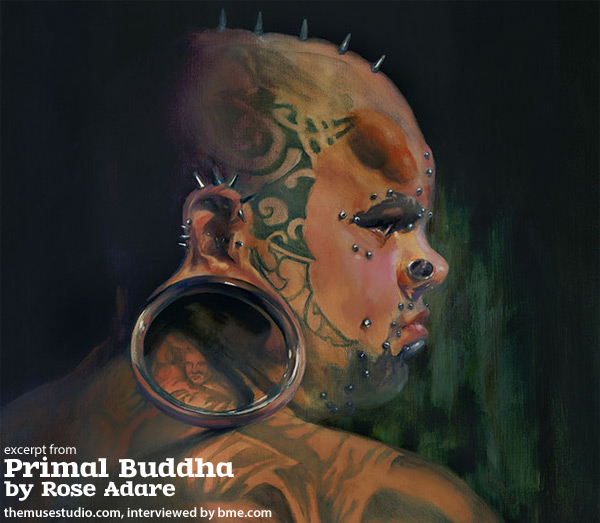
* What were you “trying to say” with this series of paintings?
When I was dreaming of Restraint & Revolution I was imagining all the different kinds of corsetry. The painting series is about how people push social boundaries, and corsets are amazing because they have transformed from a symbol of chastity worn under the clothes, to sexy, naughty lingerie worn over top. A complete 180! Everyone in the series pushes those boundaries. Kimberly Dark (Mysterium) is one of the top six LGBT speakers in the country, Carol Queen (Queen 2B4) founded GAYouth and the Center For Sex and Culture — the woman added words to the sexual dictionary! — Jason Webley (Eleventh Hour) is an underground musical genius, Buffy Saint-Marie (Sky Dance) is a Native American musical powerhouse, Ariellah Darker Still (Bring Me My Ghosts) created Dark Fusion belly dance, and Master Obsidian and slave Namaste (Genuflect) are award-winning sex positive role models. They’re all amazing because they change the world by expressing who they are. I mean, if we’re talking about body-mods and self actualization, let’s talk about Billy Castro (Bonnie is Clyde). He’s a transgender porn star. He even spoke at Stanford at the Clayman Institute for Gender Research.
* But beyond corsets of the traditional body-reshaping clothing type, you’ve also painted the play piercing sort?
Naturally, I wanted to paint a corset piercing. At the time Robert was dating the fetish model Stembot (who’s in the painting Acceptance). She leapt off the couch and said “Let’s do it!” Next thing I know, we’re at Kala Kaiwi’s mod-shop lancing eighteen hoops into her back. That’s how I met Kala. His work is brilliant. Scarification, implants, subdermals — he can do it all and he has it all. Implants in his forehead, spikes drilled into the top of his head, tattooed eyes, knotwork patterns in his skin. Everything. About a year later Stembot moved back to the mainland and Robert met Jesi Collins (Venus Unbound). She’s also an amazing tattoo artist and a wonderful mom (Robert tattooed a lot of the work on her left leg). She and her daughter came to live with us. She has a starfish implant in the back of her hand (which you can’t see in the painting because of her pose), as well as a magnet embedded in her finger to perform magic tricks like picking up paper clips and making them spin on tables. She also has a puffer-fish tattooed on her right leg so when she bends her knee it puffs up! I guess we were one fantastic, freaky family after that. We used to go down to the cliffs in the jungle and Kala would pierce Jesi’s back with these huge meat hooks then Robert would suspend her from a tree and swing her out across the water.

* How literal are you with your portraits?
I paint people as they are — though Koyote (in the painting Koyote) is wearing costume horns because he’s a fire performer, and I think they suit him. Sexy devil! However, people are motion, and paintings are still. What I mean by that is people, in life, transform from second to second. Every smile and frown and twitch creases the face, so the idea you have of them is an amalgam of these images — the serene, the troubled, the beautiful, the fear; all mashed together. A painting is like picking one character out of the play that is you. My painting of Kala, for example, is undoubtedly him, though only one or two aspects. Unlike photographs, paintings are more than a mere snapshot. They’re archetypes, like streamlined forms of self.
* What about with their body art? For example, do you try and be literal with their tattoos, or do you take liberties to make their tattoos match your artistic style or commentary?
I love painting tattoos because they are the literal meaning of organic art. When it comes to painting in general, I use sacred geometry like the vesica piscis or the nautilus spiral, blending and softening around the edges before bringing it in for detail. This means that certain tattoos come into focus, just as your eye would focus, while others phase out into basic shapes and color. People can’t see everything simultaneously, and that’s important to remember in portraiture. It’s one of the key differences between Classical Realism and Photo realism. An excellent tattoo painter is Shawn Barber. He focuses on the detail of tattoos.

* What sort of response have you gotten to this series?
The response to my art has been nothing but excellent. Restraint & Revolution will be visiting the mainland U.S. within the next year before moving on to Europe. Yet we were careful about starting in Hawaii. Hawaii’s art is Hawaiiana. Dolphins and orchids and sunset “plein air” landscapes. Hawaii is so vibrant and colorful artists have to compete with nature herself to capture anything half as brilliant. My art, because it evolves out of Classical Realism, takes on more somber tones, and there’s nothing quite like these portraits out here. Our opening at the East Hawaii Cultural Center drew more people than they’d ever had at a single event! People came out in droves, and it was a mixed house. The classic Hawiianna art scene, the local island vibe, the hippies from the jungle, the fetishists from the off grid dungeons, the college students from UH Hilo, the vacationers fresh off the cruise ship — everyone wanted to see! And the truth is, people are often afraid to ask, especially about bodymods. They want to know “does it hurt?” or “why did you do that?’ or “how does that work?” or “is her hand really magnetic?” But at the same time that little voice says “don’t stare, don’t be rude.” At the art show we posted bios of each model so people could read all about these different intersecting, counterculture, underground, subculture lifestyles.
* Beyond capturing a sense of breaking sociopersonal boundaries, is there any other theme to your artwork?
I set out to paint nontraditional people in a traditional medium. Fine art can be so stiff and traditional. Masterfully skilled but thematic. Contemporary art, especially abstract art, can be so expressive that in the end there’s more message than talent or skill. I love the traditionalists, but we can’t all be Da Vinci. I love the innovators, but we can’t all be Duchamp. Fine art needs to evolve, in the same way that the Pre-Raphaelite brotherhood broke the mold, and the Impressionists blurred the boundaries, and the Surrealists escaped reality. But there is a magic to fine art, an alchemy in oil paint, and a soul in composition that we’re losing to Photoshop and instantaneous art. Each portrait takes well over one hundred hours, and is infused with gold leaf, and santo paolo, and whiskey, and peyote — and in the portrait of Koyote even some of my own blood. Blood, sweat and tears. That’s Fine Art. Don’t get me wrong. I believe in instantaneous art, I believe in instantaneous expression, and I believe everyone is an artist, and everyone has a message, and that’s the truth. But which iconic images survive the test of time? Some changed the very way we saw the world. Look at Picasso and Georges Braque and Cubism. But others survived because they captured time and place. Toulouse-Lautrec immortalized Montmartre, as did Modigliani. I love to celebrate people. I love to celebrate our time, and the bodymod scene is a huge part of that. Blood, sweat and tears. That’s love. That’s dedication. And that’s art.
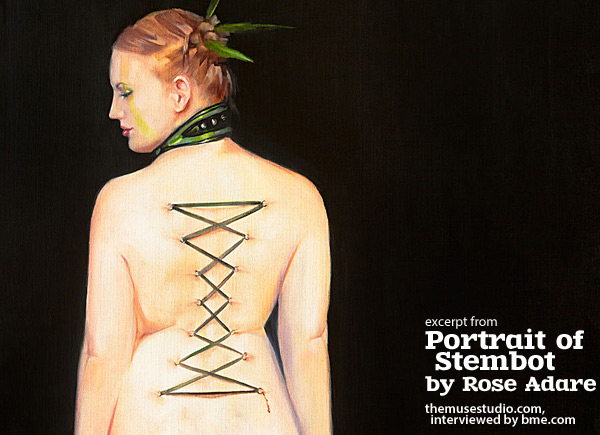
Cammy Stewart Interview
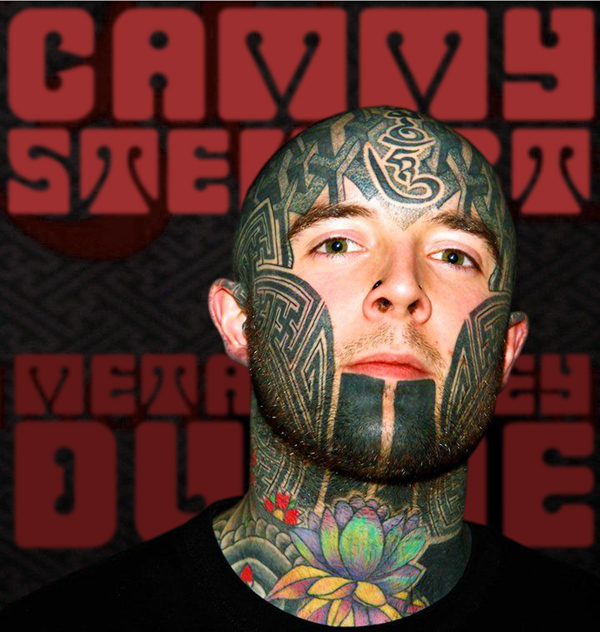
Cammy Stewart, whose work has been featured on ModBlog in the past, is a Dundee, Scotland based tattoo artist who started like most do — self-taught, tattooing anything they could on anyone they could find — but had an epiphany when he met neotribal, blackwork, and sacred geometry tattooing pioneer Xed LeHead at London’s Divine Canvas. He began merging this new style and philosophy of tattooing into his own, and became a part of what began with the idiosyncratic style of a small handful of outsider tattoo artists and has become a full-on art movement. Find Cammy at Metalurgey in Dundee, Scotland, online at facebook/cammystewart or instagram/cammytattoo, or email him at [email protected].
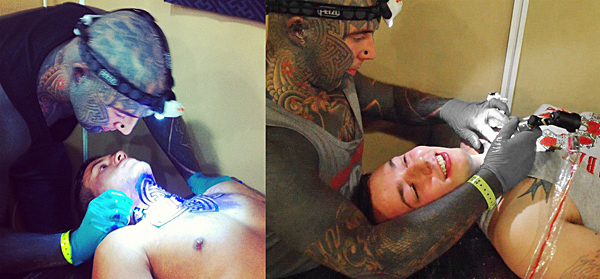
* How do you create the designs in your tattooing?
I design all pattern work I use for tattooing on Photoshop. Sometimes I draw sections by hand on paper, scan them, and then replicate or manipulate them using the computer until I’m happy with them. Any other drawing or layout for the tattoo is usually drawn directly on to the skin with a selection of pens until it is clean and easy to follow.
* Does the core of the design tend to come from you or from the client?
I like my clients to come in with a rough idea and let me do my own thing with it. The only time I like to have full creative control over a tattoo is when I either know the customer well and they trust me fully, or I get a vibe from them that they are open minded and genuinely don’t mind what I do.
People always say, “do whatever you want,” but I know deep down they don’t really mean it. If the client has existing tattoos that I have to work around or cover up this will also have a massive impact on the final design. I try to use this to my advantage and let it help with the shape, and the shape of the clients body can also influence what kind of design I use or how I place it.
In my opinion the body should be treated as a whole when possible. The un-tattooed space is as important as the tattooed space — how it fits, how it flows, how it becomes a part of the wearer and looks natural on them…
* Do you have a library of artwork that you do in advance and then look for clients for, or is it all drawn for the specific person?
I design everything for the client, and most of the decisions for the final design are done on the day. I don’t like knowing exactly what I’m going to do in advance as I feel this isn’t really the most creative approach — I like to work in the moment, for my life on that day to influence how I go about coming up with the design. It feels raw, and that’s what I get a buzz from.
I do make patterns and designs and keep them in folders on the computer for possible future use, and I also collect things I find that look interesting from books or online that I feel might be helpful for ideas or for reworking in Photoshop at a later date.
* Maybe a silly question, but why do you use almost exclusively red and black? It seems a common palette for this style in general.
The reason I choose red and black is because it is a striking combination — bold and raw, and it works well on the skin. No other colours have the same power for me. I’m not sure why they are popular as a whole though. I imagine for the same reasons that I’ve just described…
* How do you introduce individuality into designs that by their nature are somewhat repetitive?
Every day is like reinventing the wheel. People see my work and all want similar things done, but I try to persuade them that they should look beyond my previous work and do their own thing to something that will suit them — obviously I have my favourite patterns and motifs but I try not to overuse them.
* What do you draw influence from as an artist?
I draw influence from everything — my family, my friends, day to day life, emotions from within myself and people I respect within the tattoo industry. I don’t really look at tattoo magazines these days and I try not to look at too much tattoo work online as I don’t want to draw to much from other peoples work. I’d much rather look at books on graphics, street art, and so on to keep my work is as original as possible and not have it be a copy of other artists’ work…
* What would you say to the criticism that geometric tattoos are, while technically advanced, are devoid of a certain artistry?
Art to me is a raw expression of ones self, a tool to communicate with people without language… and mostly something that makes people talk, so whether you like something or hate something, as long as you want to discuss it and it makes you think, then it has much artistry as a portrait or any other kind of tattoo. And really, “what is art?”
* How did you learn and mature as an artist?
It’s been a very long drawn out process. My background was in graffiti art so that obviously has has a big influence on the tattooing I am currently doing. However, when I started tattooing I didn’t have a clue about anything. I am self taught, so the first few years I was just learning the technical aspects through trial and error — I was tattooing whatever came my way really, wanting as much skin as possible to get better.
The biggest turning point for me was meeting my now good friend Xed LeHead from Divine Canvas. As he tattooed my face and head, I remember him saying, “you wear the sacred geometry, so why not take this path and explore it for yourself?”
It just seemed like the right thing to do as I had so much respect and admiration for his work and his take on tattooing and life in general. I felt at home around him and all of the wonderful people working alongside each other at his studio. He shared everything with me –machine knowledge, patterns, tattooing techniques, Photoshop use… the lot! It got me started with this form of art, and gradually, as I got more confident I put my own twist on it and used my own art background to help me develop further… I don’t feel this process will ever stop, and if it does I’ll stop tattooing.
* Is it frustrating being seen as specializing in a specific style, or does that help you push it further than you could if you were a more “general purpose” tattoo artist?
I much prefer working in only one or two styles. I don’t feel you can be really good at everything — it’s impossible to be great at every style. I’d rather concentrate my brain on one thing and be the best I can be at it than be OK at many styles while never really excelling at any of them. Being an all rounder was never really my thing.
I also feel its easier for people to remember you and your work if you work within only one or two styles — it makes your work instantly recognizable. You could compare it to marketing a brand of anything. When I was still doing other styles, but was already changing from doing a bit of everything to specializing in one style, I felt it a good idea only to display in my portfolio the work I wanted people to come to me for rather than everything I’d done, so that in time people would know and accept that this is what I do.
* How do you see you style evolving from where it is now?
The work will evolve as the customers evolve. Without people I am nothing. What I’ve been starting to find is, as more people see my work they are keener to give me larger spaces to work on and I have more freedom with design. Everything I do inside and outside tattooing helps me grow and evolve. Also, as equipment gets better it can make tattooing more fluid and allow me to cover more area more efficiently. Long term I would like to work on larger projects rather than small tattoos, but this will only happen when the time is right.
I think geometric/blackwork/abstract work will continue to grow as new artists enter this world and do their own take on it — the possibilities of it are endless with people who are prepared to take risks and push the boundaries of modern tattooing, ignoring all the conventional rules and thinking outside the box…
I just like to tattoo and want my customers to be happy with the final outcome… I want to make images that people remember and that fit the body well.
Lesya and Rouslan
Lesya Toumaniantz’s radical facial tattoo has recently gone viral, posted on thousands of Facebook pages with captions like “next level face tattoo” from Russia. So I thought it was time to tell the real story behind this remarkable tattoo.
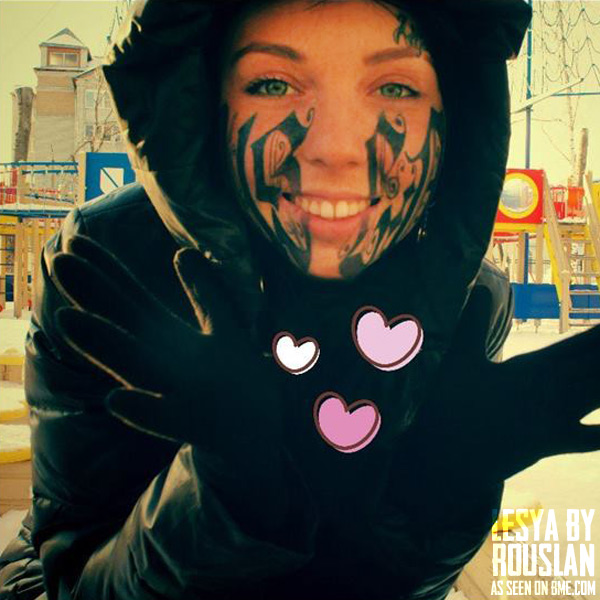
About a month ago, Rouslan Toumaniantz, a well known and sometimes notorious Belgium-based tattoo artist (of Tattoo Box in Kortrijk), and Lesya, a designer living at the time in Saransk, a city in central Russia started talking via chat (Rouslan speaks fluent Russian) and realized they had a lot in common, and quickly began falling head over heels in love. About a week ago they met in person in Moscow and decided to get married — their plans for their life together include her learning to tattoo (Rouslan tells me she’s already a talented artist), apprenticing under her husband-to-be, while she also gets the full-body ink that she’s always dreamed of (biomech is the current plan) — and of course a family.
Her new facial tattoo that’s getting all the attention, a huge commitment for both a person with limited experience as a publicly modified person and for a new relationship screams out the intensity of their commitment to their new life, reads “RUSLAN”, the name of her betrothed. At first glance the tattoo echoes Latin American gang tattooing — MS-13 is the first thing that’s come to many people’s minds — and I worry that it could complicate future travel in the Americas, to say nothing of putting her in danger in some cities (of course, these are places where deaf people speaking sign language occasionally are stabbed when foolish gangmembers assume they’re throwing rival gang-signs). But to be clear, the tattoo has nothing about committing to a life in a gang — it’s a commitment to love.
I know that there are people who are terrified that Lesya has made a rash decision that she’ll regret horribly, but sometimes the best decisions are the ones you make in an instant with your heart rather than the ones long-debated in your mind. I know many people whose favorite mods are the ones they got “on a whim”, and who are still happily married to the person they fell for the instant they saw — “love at first sight” is an old truism — and proposed to within the week. I wish them the best of luck and hope that their life plays out as they dream it to be.
Edit/Update: People have asked why it says “RUSLAN” when I’m writing his name as “Rouslan”. It’s simply because one is the French spelling, and the other is the Russian/English spelling of the name — they chose the latter because it fit better on her face.
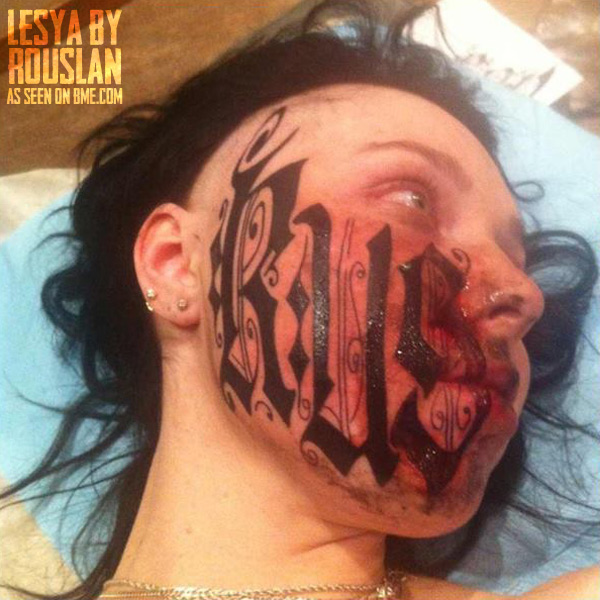
Continue after the break for a more explicit photo.
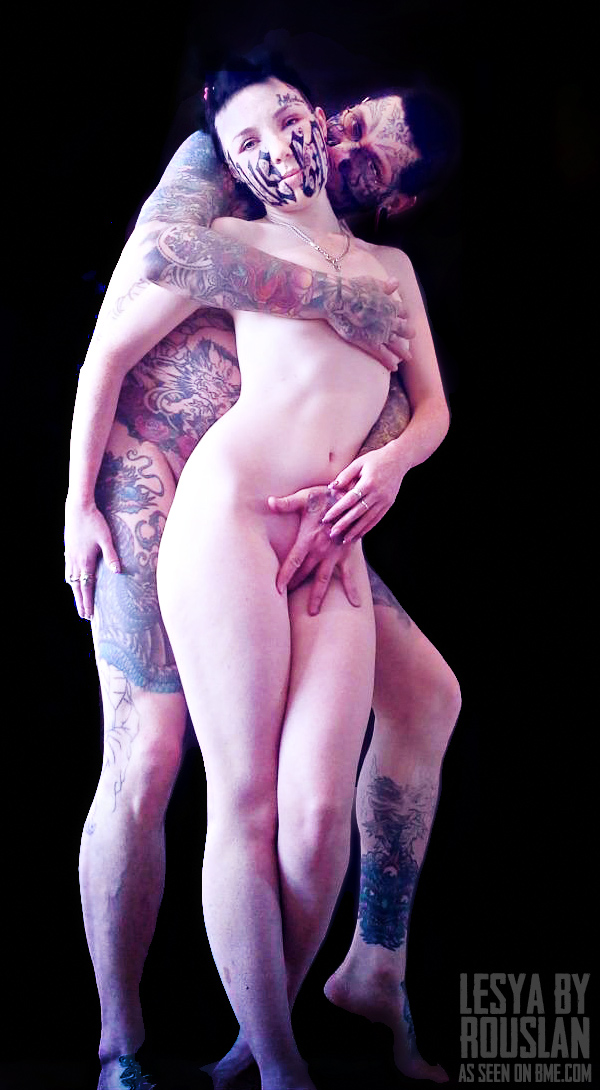
Elio: DIY Human Experimentation
I first met Tucson, Arizona-based Elio when he wrote me after I posted some pictures of saline inflation done using food color, and mused about the idea of using tattoo ink in order to dye large areas of tissue using a single injection and, done carefully, minimal pain. After he sent the fascinating results of his experiments with that technique, I started learning about his other modifications, all of them self-done and often bizarre and unique, a number of them things that no one else that I knew of had ever tried before. A number of these were made even more unique by the fact of Elio being born with female genitals which have been sculpted and enhanced not just with body modification but with hormones as part of a female-to-male gender transformation. It was a huge pleasure talking to Elio — it’s always liberating hearing the story of people who go their own way.
While the body modification community these days can be rather hostile to DIY modifications and explorations that are arguably better left to experienced professionals, because my body modification journey started in the 1980s when DIY was often the only option I have never been particularly bothered by people choosing that path up the mountain. It’s not the safest path for sure, and it’s not one that I’d recommend to most people — and for me to do so would be irresponsible given that there are safe and well marked trails up that mountain — but there are unique benefits (and dangers) to free climbing new routes or even those others have previously marked as dangerously impossible. I hope that those people who have difficulty appreciating the DIY journey, for whatever reason, will still read this interview with an open mind and accept that it is possible that there are many different valid ways to live, and that even if someone’s approach to life isn’t right for you, it may well be right for them and that by learning about journeys other than your own you can gain insights into the human experience that you wouldn’t have found otherwise. It was a great pleasure getting to know Elio, and I’m happy to share this interview, an excerpt from my upcoming book, here on BME.
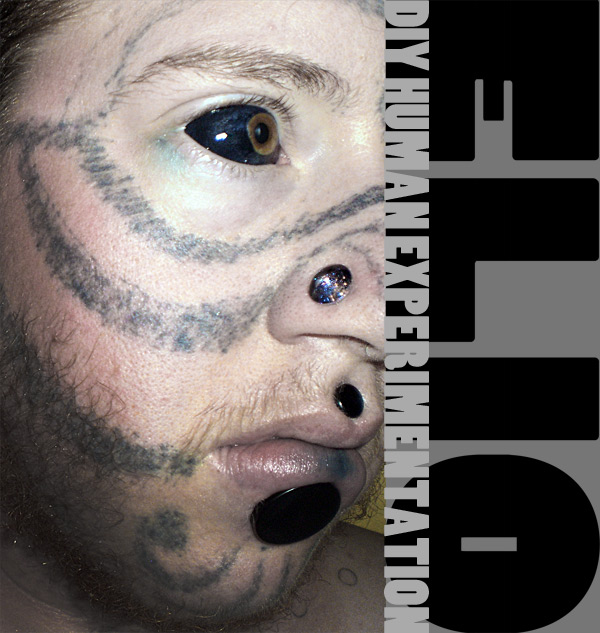
I’m twenty-six and I grew up in a very liberal, very smart, and very dysfunctional family in the San Francisco Bay Area. We — me, Mom, Dad, a younger sister and a younger brother — identified as nudist, and it was always understood that if one of us kids turned out to be gay that would be just fine. It turned out that trans, kinky, and modified were all a different matter, as I was to find out. At the same time, screaming at each other over dinner was normal, and I was constantly stressed out.
Professionally, I did tutoring for about eight years, but education was never really where I wanted to be, so I tried going back to school to switch gears into a Masters in biomedical engineering. My undergrad degree was in linguistics. Since I was sixteen — also the age at which I started college, though I don’t think these two things are related — I’d been getting migraine headaches that had been getting steadily worse. By my first semester of graduate school when I was twenty-four, I was getting them every day, leading to a major breakdown I still haven’t recovered from entirely two years later.
Since then, I’ve been applying — unsuccessfully, so far — for disability and trying to work on my writing. I wrote professionally for those silly eHow articles before that dried up, participated in National Novel Writing Month, and now I’m — slowly — working on a novel I hope will actually be publishable.
Are you still practicing nudism?
Not actively, no. I am known for not noticing I’m still unclothed at my BDSM club, though. I recall taking a break from a scene for everyone to go eat, only to learn there was an unspoken rule not covered in my orientation: “Don’t go in the food room or lobby naked.” However, I was saved when someone pointed out that I wasn’t naked — I was wearing socks! A few months later the council ruled that genitals must be covered in the food room, I think entirely because of me.
How did you realize that you didn’t quite fit into the gender you started in?
I like to say there are trans people who are more trans — the types who fought to do it even in the fifties and sixties when it was extremely hard — and there are trans people who are less trans. I’m in the latter category. Yeah, I fought against wearing dresses growing up, but because my family was so open in talking to us about sexuality, I never went around under the delusion that I’d never menstruate and would instead turn into a boy when I hit puberty. My mom has always gone on and on about what a bum deal being a woman is, so I figured I was experiencing what everyone born female experiences. When, upon being introduced to Lois McMasters Bujold’s work, I strongly identified with the hermaphrodite character, I just thought it was me being strange.
It wasn’t until I started spending a lot of time in the queer community and met some transmen that I started seriously considering transitioning. I originally got involved with the queer community because, having identified as bisexual for years and still feeling that something was wrong, I thought I’d try identifying as lesbian. That lasted about two weeks before I fell in love with a gay man. I now think I had assimilated the stereotypes about lesbians, and assumed that the reason I felt abnormally masculine for a woman was because I was really a lesbian.
I started living as a man mid-2009, came out to my family that Christmas — “ruining the holidays for everyone,” they called it — and started taking testosterone on St. Patrick’s Day 2010.
Where do you draw the nature vs. nurture line personally?
I think — and a couple family friends agree — that my mother’s negativity about women stems from not being comfortable as a woman herself. So that would seem to imply that her negativity is really just a manifestation of a genetic tendency toward being slightly trans, so I guess nature is your answer.
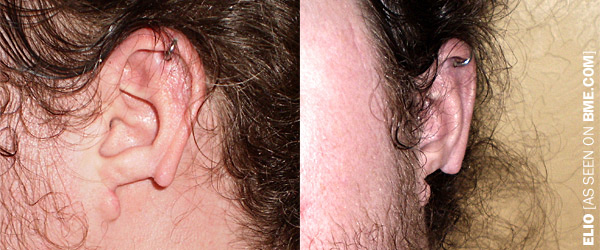
Elio’s left ear, showing his lobe removal.
What first got you interested in body modification in general?
I was always fascinated by people I saw with piercings or tattoos. I was about eight when a character in a book I was reading had three piercings in each lobe, and I thought that was just the wildest thing I’d ever heard of and wanted that for myself some day. As a compromise, I asked my mom if I could get just one extra piercing in a lobe — I thought I was being smart, arguing that I could put to use the stray earrings that had lost their mate.
But she said no, and I managed to repress my interest until I was fourteen when I pierced my nipple with a safety pin. To keep this a secret in spite of the fact that we considered it normal to change clothes in the same room with each other, I had to pretend I was embarrassed about my adolescent body, wearing bras I never really needed so I could keep them hidden.
When you start taking T, how quickly do you experience changes like clitoral enlargement and general masculinization?
I still can’t grow a decent beard after three years, though I suppose being fair-haired doesn’t help. On the other hand, a couple weeks after my first shot, I looked down at my clit and said, “Holy ****!”, because it had at least tripled in size. No one prepared me for that happening so quickly. Body hair came in slowly over the first year and a half, same with the fat redistribution away from the hips and into the belly.
Did going on testosterone change any of your body modification interests?
It might have made me more likely to act on my interests; I don’t really know. Then again, after starting transition, being interested in body modification was my last bastion of closeted-ness, and I think of my transition more as clearing the way for my biggest and most important coming-out — that is, living openly as a heavily modified person.
The world seems pretty mod-friendly these days, so why were you uncomfortable coming out about that?
My parents are very against it. I think it’s harder for female-bodied people — there’s such an incentive to keep your body “pristine.” I even had that sense for a long time; the thing that made me lose my iron grip of control on my interests was when I was left with appendectomy scars at fourteen. I figured that my body was no longer “perfect,” so why hold back any longer?
For sure — even in today’s age where piercings and tattoos and so on are very popular and accepted, it is very true that women are still expected to meet a very specific profile with their mods. As they say, the more things change, the more they stay the same…
At least I’ve never had anyone use the expression “ruining yourself” to me.
I also think the unfortunate fact that body modification is associated with criminality and drug life played into it. My family is a little subtly classist, even though we were only ever upper-middle class ourselves. I felt a lot of trepidation that people would assume I was a “lowlife” or “scum” if I talked openly about my interests. Sure enough, nowadays I do get people assuming I’m on heavy street drugs or have been to prison, but I just don’t care that much anymore.
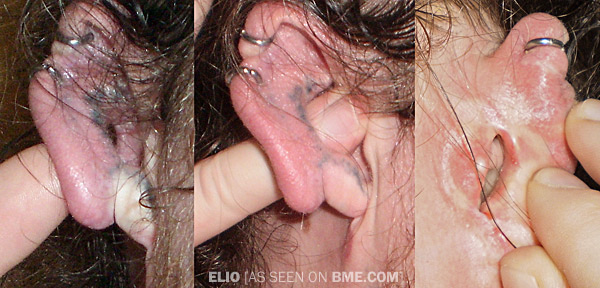
Elio’s right ear, showing tissue removal (both lobe and cartilage — conch and helix rim), piercings, and experimental tattooing.
I remember ages ago going to the premiere of the wonderful F2M documentary “You Don’t Know Dick” and it having a funny scene of people talking about how their sex drive kicked into high gear and became more “vulgar” to shorten what they said… I was curious if you’d experienced anything like that?
I feel like I keep accidentally failing to answer what you’re getting at about the T. Hopefully this time I’ll be more on the mark.
I’d always had a high sex drive, and that really didn’t change. The only thing that changed was that the swings were more drastic — rather than an almost constant low level of arousal, I went through a time where disinterest would suddenly spike to urgency in a way I hadn’t experienced before.
That’s funny given that there’s the stereotype of mood swings being more closely linked to female hormones than male.
Yeah, well, some stereotypes are bullshit.
As far as being more “vulgar,” I do find that I “get” dirty jokes and innuendos all of a sudden. It’s weird that I spent so many years constantly thinking about sex yet having the jokes sail right over my head. It’s like I’ve suddenly learned another language. Puns, too, are something I used to never get and accepted that was just the way I was. With T, suddenly I was not only getting them, I was finding them funny and making my own puns. I never expected this weird shift in my perception of language, because I’ve never heard anyone else talk about anything like it.
What modifications do you have now?
I’m sure to forget something, but I have many tattoos, mostly DIY hand-poked with various sizes of tattoo machine needles — face, eyes, neck, ear, forearms mostly sleeved, upper arms some coverage, hands, various front of torso pieces, nipples, clitoris — or “mini penis,” as I like to think of it — right leg significant coverage, and left leg some coverage. You’ll notice that one of the most-tattooed places on people — the back — is completely blank on me because (a) I can’t reach it, and (b) I can’t SEE it, so what would be the point? LOL.
Why do you mostly do your own tattoos?
It’s mostly a cost issue, but at the same time, most of my professionally done tattoos — there are only five — are based on designs I’d drawn. Once, I decided to get a piece of flash off the wall just to see what it felt like for contrast, and even though the work is stunning, I feel a certain detachment from it, a certain alien-ness. I have this bizarre sense that it’s a fake tattoo because it doesn’t feel connected to me the way the others do. So even if I were to get more money, I’d probably stick to coming up with my own designs.
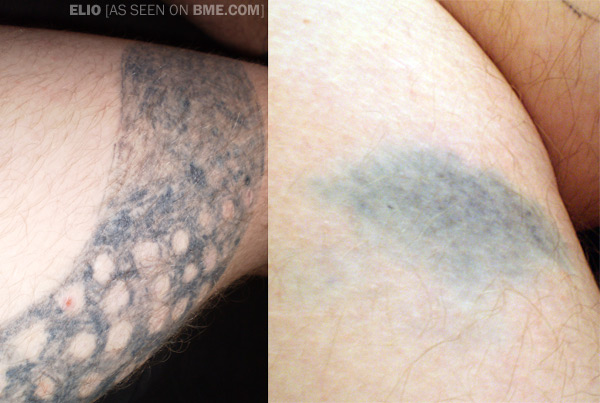
Some of the DIY tattooing Elio has done on himself. The blurry cloud of ink on the right was done using an injection method.
I totally get what you’re saying about your back by the way — I never had particular interest in a tattoo or body modification that I can’t see or experience… I do these things first and foremost for myself, not because I want to impress others.
It’s weird how people don’t believe me when I say I do it for myself. I’ve decided to accept that most people must make decisions about their appearances based on getting reactions from the outside world, since people so consistently expect that to be the motive for my behavior.
Honestly, I think that a world where it’s assumed people get modified for other people rather than themselves is a sad reflection on the popularization and gentrification of body modification.
When I first got into it, everyone was doing it for themselves, because they enjoyed it or got off on it on some level. There are still people like that, it sounds like you’re one of them, but I think that because mods are so public and so mainstream these days, they have the same “peer pressure” style influences on people are fashion or music and so on. It’s hard for people to do it for themselves these days because it’s now a part of shared society, rather than a private or at least outsider activity… In some ways I really miss the days when it was still punk or fetish and so on.
Nah, if I’d have lived back in those days, I would have become convinced I was crazy for wanting these things. My dad still thinks I’m not admitting that I have bipolar disorder and schizophrenia, and that if I’d continued to be on tons of psychiatric meds I’d never have modified myself to this extent. This completely ignores that I modified myself that whole entire three years, too, but he’s never been particularly open to reality when he’s made up his mind.
Anyway, as far as my piercings go, they’re all DIY, and I have a 23mm scalpeled labret, 8mm dermal punched philtrum, 9mm dermal punched nostrils, 6mm retired septum, three 14ga helix — through healed-over old 8mm dermal punches — 5mm scalpeled navel, 10mm stretched apadravya, and an 8mm retired scalpeled side of hood piercing.
I love that heavy clitoral apadravya piercing by the way.
Well, it may be “heavy” in the sense of “extreme,” but thanks to a Teflon barbell from Aesthetics, it’s actually very light! I wish I enjoyed weight there, as it’s a psychological turn-on, but my body doesn’t like it.
What do you mean your “body doesn’t like it”?
Weights are painful and cause sensitivity in a way that makes me slightly panicky rather than turned-on. It’s like sounding in that I’ve done it on myself for lack of anyone else to do it on, but eventually stopped that and made do with my imagination.
Are you trained as a piercer? What made you decide to go DIY?
I’ve never trained or worked as a piercer. I flub some things, but I’m happy with my success rate. Frankly, some of the most crooked, shallow piercings I’ve gotten are the professionally done ones. Added to the difficulty of finding someone qualified and willing to attempt some of these things and it’s just easier to do it myself.
I also think I have an advantage when working on myself in that I don’t have to use a clamp or receiving tube or cork — I can just put my finger on the other side and FEEL where the needle is going to come out. That, combined with the fact that I have no qualms about immediately redoing a piercing, means that I’m much more precise about placement. I also enjoy the ritualistic aspect of doing these things alone, in my own private space. Again, I just don’t get the same sense of ownership if I go out to a professional establishment and make a commercial exchange.
In addition to my piercings and tattooing, I have many surgical modifications, which are all DIY as well, other than my bilateral breast reduction which was done by a plastic surgeon. I have a split tongue, which I have redone at least six times to deal with regrowth. Also a right ear conch removal — that’s just partial until I go back and fix it. I had 1″ lobes in the past, both ears, which I attempted but failed to reverse. Eventually I intend to remove the leftover knobs of flesh and just be lobeless. I’ve done a quarter of this so far. My nipples were split both directions with a scalpel, cutting out from a pair from stretched horizontal and vertical piercings plus a central pocketing. I also have both labia removed, a hood split which I made by scalpeling out a 5mm piercing. Eventually I intend to remove the hood completely. Finally, I have a female subincision — I opened the split with a scalpel, starting with a female PA, a Princess Albertina, which I had stretched to ¾”.
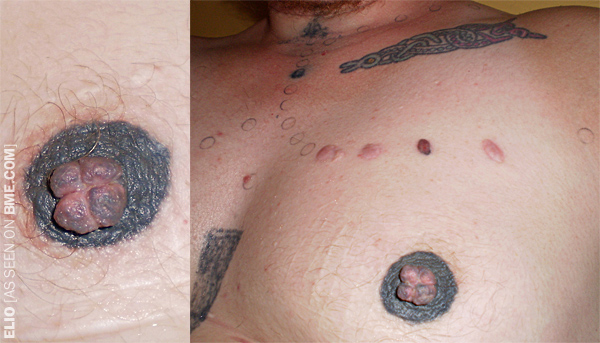
Elio’s chest showing (among other things) round ink-rubbings done using a dermal punch and tattooed split nipples.
Now we’re getting into fascinating territory — heavy female genitals mods seem so rare to begin with.
Why is that, anyway? I await the day when someone comes up with a plausible theory.
I personally think there is a strong link between male sexuality, male “mating dance behavior”, and testosterone in general with body modification of this specific type.
With your ¾” PA — do you mean placement, or stretched size?
Yes, the jewelry size. I pierced it at 10ga, I think, and it healed and stretched so fast I was up to 00g within a month. At ¾”, wearing a tunnel, I actually had this strange problem that it directed the urine stream backward and irritated the area that rubs between my thighs. Plus, I wasn’t sure I liked the way it stuck out of my vagina; it looked kind of silly, like a tongue or something. I’d never heard of a female subincision, so I decided to go ahead. The whole thing was practically painless, from piercing to split. Since then, I’ve noticed I do get a few more UTIs than I used to, but since I can reliably cure them by drinking a glass of cranberry juice at the onset, it’s not a big deal.
What made you want the PA? Were you into urethral stimulation?
I knew it was very rare and as far as I could tell, no one had stretched it to a significant degree. I wanted to find out what would happen and what it would look like… I wanted to be into urethral stimulation. As time goes on, I keep giving up on the idea of being a fifty-fifty switch and realizing I’d just rather do most of these things than have them done to me. But it’s really hard to find someone even into sounding, let alone cutting or what I ultimately want to do, which is modify someone else permanently as part of a scene, repeatedly.
It’s weird because the PA piercing sounds so extreme, but it was so easy, fast, and painless. I think I got onto the idea because I’m mentally turned on by sounding, enough so that even though it’s more uncomfortable than pleasurable for me to receive, I’d been playing around with it on myself for a while.
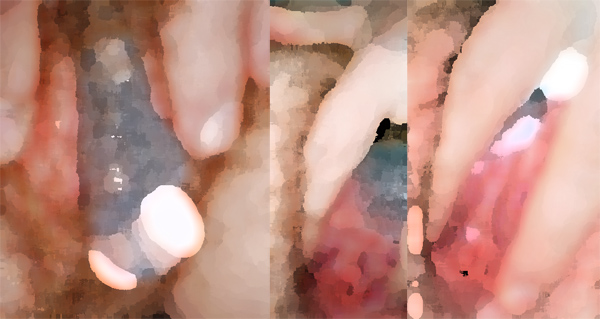
Elio’s genital mods: On the left, his stretched clit piercing and hood tattooing, and on the right, his “female subincision” created by cutting out a stretched Princess Albertina piercing. Click to see uncensored.
How does your subincision run anatomically?
The distal end of my urethra is open to my vagina.
What procedure did you use to do it?
I just cut through the piercing. I’d just stretched up a couple days before., so the stretched parts hanging off the opening kind of tightened up afterwards, which was nice. I’ve had that happen before — after having my retired 00ga helix punches healed down to open 2ga and 4ga holes, I stretched back up to 0ga and retired them again — only this time the holes healed right over. I think that’s a good thing to try if you’re trying to shrink a stretched piercing — stretching up and then removing the jewelry after a couple days with the stretch not healed yet.
How about healing?
It barely bled at all, there was no pain beyond an extremely mild stinging when peeing for a day or two, and there were no complications. Easy-peasy.
Did it have a functional effect?
Whereas sounding is painful for me on removal, I like stimulation around the urethral opening. The subincision enhanced that sensation when receiving vaginal penetration, which I enjoyed a great deal back when I was doing a lot of that.
It’s hard for me to understand the length of the subincision exactly in terms of how far it runs. It just mostly just cutting out the big PA, or does it run up the shaft of the clitoris, thus exposing more nerves? I guess at that point the anatomical parallels start to diverge a bit.
Yes, they do, because the clitoris is a pretty separate entity from the urethra. Okay, so imagine you have a soup can and you glue a straw that’s the same height as the soup can to its inside, standing up vertically. That’s like the vagina and the urethra. If you cut a slit in the top end of the straw, that’s essentially what my subincision is like. And then if you really stretch the metaphor and get one of those little hot dogs people use for pigs-in-a-blanket and set it on the counter nearby, that’s my enlarged clit.
The subincision is just basically me cutting out the large piercing. Since the piercing protruded a bit, I’d guess the subincision goes in maybe 12mm. Considering the female urethra is only like 6 or 7cm long, though, that’s not an inconsiderable percentage.
Another interest of mine is scarification, some done with a dermal punch, and some of it with a punch and ink-rubbing. I’ve never seen anyone else do that yet, but it’s such an obvious idea.
Was your tongue split done over six sessions because you were just cutting slowly?
No, actually. The first time I got it pretty far back, but every time it healed, it returned to an unsatisfactorily short split. Realizing this was partially because I was having trouble getting the scalpel far enough back in my small mouth, the last time I used surgical scissors, and that seems to have worked a little bit better.
The first time I did it, I was actually just playing around with large-gauge temporary tongue piercings. I was nineteen and living with my mom, and I wasn’t allowed to have non-ear piercings at all, so I played with these things late at night and took them out right away. I’d been mostly piercing and stretching — that is, ripping — to larger sizes, but I knew scalpeling was supposed to be cleaner and result in easier healing. But once I’d pushed the scalpel — okay, actually it was an Xacto craft knife that time — through my tongue, the blade was facing forward as I had it, and I was on such a high from the sight of it that I kept cutting all the way. That still wasn’t enough to satisfy my need, though, so I risked pissing off my mom even further by also cutting my 00ga lobes to 5/8″. I thought I’d be able to hide these things — I had long hair — but I was wrong.
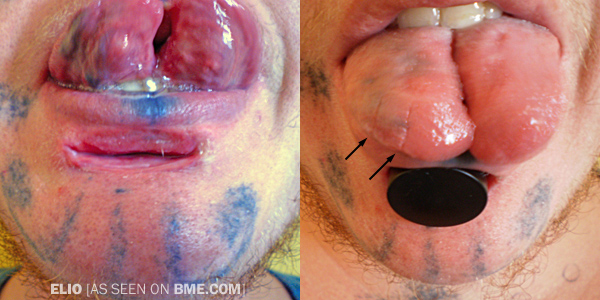
Elio’s tongue splitting — note scars from attempted “octopus tongue” as well as his injection tattooing of the lip and tongue.
Did cutting and re-cutting it like that affect the way it healed? More scar tissue or an unevenness or anything? I assume you weren’t suturing it.
Yeah, I wasn’t suturing it. I knew some professionals weren’t using sutures, either, so it didn’t seem worth the trouble to get the materials and learn how to do it. I don’t think it affected healing at all. Whereas it still could be deeper, I’m very pleased with it aesthetically.
Oh, that reminds me, I should have mentioned — somewhere in the tongue-splitting FAQ it warns that a three- or four-way split would “likely end in disaster.” Well, I tried going in about half an inch on one of the existing forks just to see what would happen — I didn’t think there would be a terribly great “disaster” just with that short split. You can see from the pics that you can’t even tell it’s there, really. I didn’t like it at all — unlike the original split, it didn’t feel natural, and it wasn’t the turn on I expected. The outside part of the split went kind of numb. For what it’s worth, I was able to pull it apart with my muscles; it wasn’t just a passive lump of flesh. But it healed back together quite quickly, and that was the end of that experiment.
It’s sounding like DIY is something that’s very important to you. Does that permeate other aspects of your life as well?
Haha, yes. I’m very bad about asking for help when I need it. That combination of stoicism, independence, and stubbornness ends up hurting me a lot, as you might imagine. If I hadn’t kept insisting I could do it just to prove it to myself, I would never have tried to work normally for as long as I did before finally admitting that my migraines are too big an obstacle.
You seem to really enjoy using yourself as an experiment.
It’s less enjoyable than compelling. It’s similar to all my creative ventures in that way — it’s not “fun” per se, but it’s something I find so interesting I can’t not do it.
Given the warning you’d read why did you do it?
I’m a little mulish when it comes to warnings. “Oh, you’re telling me not to do this? Well I don’t have to listen to that! Watch me do it anyway and turn out fine!” If I read a warning somewhere that it’s a really bad idea to impale your entire body on a 20cm wide spike, I’d probably have a great deal of trouble getting the idea out of my mind. I wouldn’t do it, but I’d keep returning to the thought.
When you did the “octopus tongue”, for lack of a better name, do you have an sense as to how that would have turned out if you’d forced it to heal, say by suturing it?
Haha, “octopus tongue” is a perfect name for it — even though octopuses probably don’t have tongues. I think it would have just have continued to be numb and awkward-feeling. It feels fine now that it’s healed back together. There’s a little strip of scar tissue I can feel if I try, but that’s it.
What made you decide to do the labial removal and hood removal? Was that related to trans interests, or mod interests?
Both. I can’t really separate it out. I always hated my labia; they didn’t enjoy being touched, and I found them ugly. I was always attracted to the idea of having the area clean of superfluous folds and having nothing but the clit there.
Do you mind me asking about you sex interests in general, or is that no-go territory? I’m also curious about whether testosterone has influenced them.
I’m pretty open about my sex interests. I think it’s important for kinky people who CAN be out to do so to increase visibility.
The first year on T, I had copious amounts of sex with a veritable plethora of partners — mostly gay, bearish men, but some straight men were still interested for a while, and if there was BDSM involved and there were no guys around, I could go for women, too. I’d been enjoying slutting around for a couple years before T, though, so I think it was only maybe a 50% increase in activity. I did, however, go from virtually never masturbating to doing so about twice a day — almost always with a vibrator for efficiency, even though it seems like a kind of womanly way to get off.
Then, when I had the aforementioned breakdown, my sex drive kind of shut down for a while, except for masturbation. That time period was when I finally committed to being irreversibly visibly modified. I realized that I’d always had a conflict between being a performer and being modified, and that every single stinking time, I’d chosen the former over the latter. It was time to make the other choice. Besides, I’d discovered improv comedy, where your looks are pretty irrelevant, and I’d turned into a gamer — where your looks are REALLY irrelevant — when my sister introduced me to Magic: The Gathering. Anyway, the weird thing is that now that I can look in the mirror without being startled by my lack of modifications, and I really don’t care to have sex with other people any more. Being able to just cater to my fetish made masturbation that much more satisfying. My modification motivations are 40% fetish, 35% a matter of be-who-you-are, 15% love of experimentation, and 10% spiritual.
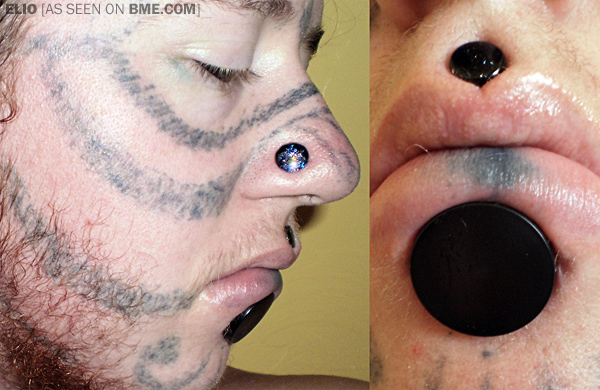
Elio’s self-done facial tattooing (note lip tattoo).
What gave you the idea of doing tattoos by injecting the ink instead of just tattooing it?
The idea began because I was trying to accomplish something that would be more like an implant than anything. I wanted to have bumps filled with color on my leg, and, being a cheap bastard, I tried this with acrylic paint, figuring that at least it’s non-toxic.
I guess you discovered there’s a big difference between “non-toxic” and “bio-compatible”!
I knew there was; I just wanted to make sure I didn’t go crazy from lead poisoning while experimenting. I’ve also always been comfortable with mods “going wrong” — I enjoy the strange scars and configurations that result from accidents as much as the successful mods. I figured one of three things were likely to happen: it would work, it would push back out of the skin and scar, or it’d become infected and painful and I’d have to debride it myself. I was comfortable with any of those three options, and could at least tolerate the possibility of having to seek professional medical care. The green and yellow ink stayed, but the other four colors all pushed back out in a long, painful process.
Long painful process?
It took months with the paint weeping back out the injection site or forming new holes to the surface. I’m a picker — I can’t seem to help it — so eventually I hastened the process by picking away the skin that was on its way out anyway, leaving me with irregular craters in my skin there. I kind of like the result, as it’s hard to get a depressed scar like that except by sticking something non-bio-compatible in there. I did have a rash of mild food allergies for a couple years afterward, and someone I knew said that was linked to tattoos in general, so maybe the yellow and green weren’t completely inert. Anyway, now my body seems to have successfully encapsulated them, and they’ve given me no trouble. Some of the green did weep a bit, which is why there’s a white spot in the middle of those areas, like a collapsed caldera.
Later, I moved toward injected ink that I hoped would to spread out. When I did my eyes — yes, I saw the idea on the internet — I noticed how the fact that there isn’t really any tissue that bonds the conjunctiva to the sclera, or any tight fibers running vertically that would stop the ink from spreading. In addition to the eye, I’d seen a photograph on ModBlog awhile back where a guy injected his own blood under the skin of his penis and got a cool, color-changing temporary tattoo. The two ideas just sort of melded in my mind, and I injected black tattoo ink under the loose shaft skin of my tiny penis.
Just that spread out really well and covered everything but the underside, where the tissue is a lot tighter. It’s very similar to the inside of a subincision there, which makes anatomical sense. I was really impressed with this, so I tried putting some ink in the head as well, which just came out like random black blobs even after three or four attempts.
As I played with this more on different parts of the body, I realized the shallow injections just under the skin don’t work very well unless the skin is very loose. The process hurts like hell wherever you do it, and the ink just doesn’t spread out enough most places to justify using the technique over normal tattooing. However, the one time I managed to get the ink into the fat underneath and it spread — this only worked the first time, so far — I got an interesting, result kind of like a permanent bruise. I just wish I could get colors other than black to work that way, as I think it’d be neat to extend the idea into a rainbow thigh piece.
Healing isn’t too bad with this, though the swelling on top of the pressure created by the ink itself is more painful than you’d expect. Honestly, I’ve never gotten a serious infection with any mod I’ve done. I don’t even really bother with sterility unless I’m doing something extreme, as (a) I’m lazy about prep work, and (b) I look at all the indigenous cultures that do these things on the ground in the dirt with completely inappropriate materials — yet you never see them with ripped piercings or other failed mods. True, some of them probably die from infection, but if I ever got a serious infection, at least I have access to antibiotics.
I said something similar in one of my old FAQs — if the piercing can be done in a dirty environment using simple homemade tools, it’s probably relatively low risk. You do however occasionally see indigenous people with torn earlobes and such of course…
I’ve actually yet to run across an image of that, though I always figured it must happen. In general, I think our bodies are much more durable than we give them credit for. I’ve always figured that if I were a piercer, I’d be slowly driven nuts by people being overly anxious about mild mods.
By the way, I’m always impressed when people tattoo their own eyes, and I think there’s a kind of nihilism to it as well…
Nihilism? I don’t know about that… I think I’m too happy to be a nihilist.
I know, but I think with eye tattoos, other than people who are blissfully unaware of risks, you have to have a certain moment of “fuck it, if I go blind, I go blind”… It may have been a little different for me because I was the first to do it, so we were much more in the dark about what might occur.
It was more like, “I’ve yet to hear of anyone going blind; that may just be an overreaction of a warning. Plus, if I do go blind, it would be a whole new way of living life. Sure, it’d be frustrating and disheartening at first, but it would also be a challenge and an adventure.” Since then, I’ve learned that studies show people who lose a limb involuntarily are less happy than they were for about a year, but after that they go back to being just as happy — or unhappy — as they were before. That’s made me a lot less anxious about the potential of getting in a bad car wreck, which I worry about a lot more than I worry about any ill effects of my mods.
What was that experience like? Did you do full coverage or just a spot?
Full coverage. I did the right eye, two or three injections, and it was easy and looked gorgeous. Then I did the left eye… aieee! Why is one side always so much harder than the other in bilateral mods? I absolutely couldn’t get part of it to fill in — still haven’t, after multiple revisits — and healing on that side featured my sclera kind of detaching in a fluid-filled blister — which I popped with a sterile needle — blurred vision, a headache so bad I thought I was having an aneurysm and went to the ER, and black “floaters” in my vision for a year afterward.
My optometrist has since informed me that there’s ink on my left optic nerve, making me at risk for glaucoma because the ink molecules, like the melanin molecules in dark-skinned people, can block the flow of fluid out the fine mesh in the retina. Oh well.
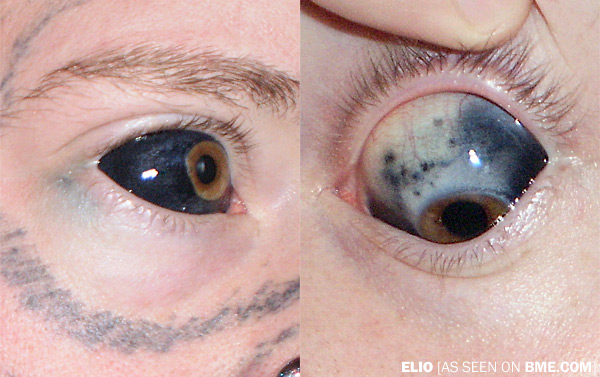
Elio’s DIY eyeball tattoos, one eye with full coverage, while the other eye had trouble fully accepting the ink injections.
Can you tell me more about the problems you had?
I used an 18ga draw needle on a 3cc syringe to draw up about 1cc of black tattoo ink directly from the bottle — to avoid contaminants from involving extra containers — I switched to a 25ga needle to inject the ink. I put the needle in open side down. I wasn’t sure the needle was in far enough at first, but when I tried depressing the plunger, the ink went right in and spread out over about 40% of my right eye. I repeated this with similar results twice on the right eye and twice on the left eye.
The other twenty percent of the left eye refused to take ink. I tried injecting shallower, deeper, in different locations, but after about six times, I gave up. It had black spots where the needle had been, but the ink wouldn’t spread out. I later repeated the procedure on multiple occasions with similar lack of results.
My right eye produced no pain and healed fine except for minor leakage into the area around the eye, giving me the “black eye” effect over about a square centimeter. I was a little light-sensitive the first week of healing. Two days after the initial procedure, my left eye… how do I describe it? It’s like the whole sclera detached and was kind of floating free in the eye socket, though tied down to the cornea still. It was also swollen like a blister. Once I lanced the blister with a 25ga needle, clear fluid leaked out, and the sclera went back to normal, though still very loose and jelly-like. Over the next two or three days, that healed back to normal.
Meanwhile, day three I got that monster headache I mentioned. At the hospital, I was keeping my eyes shut or squinted because of the light sensitivity, so they never knew about the eyeball tattoos. They said it was just a particularly bad migraine, which is what I thought, too, for a long time until I kind of reassessed what had happened. The headache was tolerable with aspirin the next day. As far a the glaucoma risk, I don’t know much more about it than what I already told you. The “floaters” were teeny black specks that tumbled down through my vision for a year afterward, but since have disappeared — I assume they eventually collected back on the optic nerve as the eye filtered out that fluid.
Do you feel that there is a male bias in body modification in general? Or in heavy modification?
I’m not sure it’s a matter of “feel” on this one — someone must have studied this at least to the extent of counting up the number of men and women in body modification, and I’m sure it would come out biased toward men.
How do you think this could be addressed or corrected — or do you think it will always be that way because it’s reflective not just of societal pressure, but of legitimate differences in the way genders express themselves?
We haven’t exactly talked about it from a community angle yet. I don’t know if it’s something that needs to be “corrected”, or that we’d get a 48-52 split in the absence of societal pressures, but when an activity is this men-dominated — I’d guess 90-10 in heavy modification — I have to think it’s more about cultural norms than anything innate. Men and women just aren’t that different; we’re all people.
If the ratio does change, I think it will just take time. It’s popular to say that women stay away from men-dominated activities because men are jerks toward them when they try to get involved, but that’s always struck me as a rather pat explanation. Anyway, writing a finger-wagging “Men, you’re being bad!” isn’t really helpful, because any man who actually is a jerk isn’t going to think you’re talking about him.
For people who are ignorant to trans-culture, I think it might be worth explaining “what’s the point” of becoming a transman and having a relationship with a gay man… I mean, why not just be a straight woman with a straight man? What’s the difference?
If there’s anywhere you don’t want to pretend to be someone else, it’s in your intimate relationships. I was very uncomfortable with straight and even bi men needing to see me as a woman to be sexual with me, because I knew “woman” was the one thing I wasn’t. It’s really hard to have people perceive you as you are over a dinner conversation, but then to have that go out the window as soon as you’re naked.
Do you ever wonder if it would have just been easier to “pretend to be normal”? Be a housewife with a white picket fence and two and a half kids or something? As wonderful an adventure you’re on, it can’t be easy on many levels.
The trope of the mad housewife makes me want to laugh and cry simultaneously whenever I see it, because I think that would have been me in another time. I’ve been relatively spineless about standing up for who I am even now, so if I had been born in an era when it was harder, I probably would have lived a life of secrecy, shame, and deep malcontent with my “normal” life.
I know that at 26 you’re still coming to terms with your own life, but since there may be numerous people going through the same thing, but teenagers that may be ten years earlier in their personal journey, is there any advice you’d give to a younger version of yourself? Be it about the body modification journey or about the trans journey…
Don’t doubt yourself. When people say something’s “just a phase,” they’re often putting their wishful thinking onto you. Don’t listen to that nonsense if your gut says otherwise. Also, it does get better, but it takes longer than you’d think possible, and it gets better in unpredictable ways, along axes you weren’t even aware existed.
I wonder if anyone will ever start an “It Gets Better” project for modified youth the way there’s one for queer youth?
* * *
This interview easily ranks as one of the favorite interviews that I’ve done in my time covering the body modification subculture. If you would like to get in contact with Elio, you can do so by email at [email protected], and if you enjoyed this interview I highly recommend my earlier conversation about body modification and gender issues with Ashley Crawford. Finally, as I said in the introduction, I should mention that this interview is an excerpt from my upcoming book on private body modification practices, which will be available within the next couple weeks. Information on that will be posted when I have it but not before, so please don’t ask me in the forum on this interview.
Arriving on the Red Eye
Well, well, it seems that Brazil’s population of eyeball tattoos has just jumped dramatically in the last week, with Emilio Gonzalez having done a handful of them, and also Rafael Leão Dias of Dhar-Shan in Jundiaí, who did the striking red eye pictured below that’s going to leave nineteen year old Mary Jo with a life of assuring people she hasn’t been injured. As I’ve said many times, I really like colored eye tattoos a lot.
I know I’m sounding like a broken record on this point, but I think it’s justified — I really implore people to exercise extreme caution and respect with this particular mod. For example, if a practitioner wants to forge ahead and isn’t interested in playing it safe and waiting until the procedure has been thoroughly developed and training is available, I’d really really urge them to use a similar learning curve to Howie five years ago — do a number of small single test injections and get an understanding of the anatomy and how it behaves with the smallest amount of damage. With eye tattoos, remember too that less is more. You want to inject the absolute minimum amount of ink you can get away with — the more ink, the more risk. Do not underestimate the effect it will have on someone’s life if something goes wrong. Hell, even if everything goes right, don’t treat this lightly — be sure that your client is mature enough (and I’m not saying that a teenager can’t make drastic permanent life-altering decisions — that’s got to be handled case-by-base) to understand that if they do this, they will never, ever, ever have a normal life.
Given how many people — even people inside the piercing industry — are having stretched ears reversed, I have real serious concerns about the regret train that could come smashing into us in ten years over eye tattoos (and that’s assuming that it’s as safe as I believe it is and there’s no larger apocalypse). Stretched ears have a very minimal impact on ones social and public life when compared to eyeball tattoos. I’m not telling anyone not to do these things. It would be silly and hypocritical for me to do so. Personally I think eyeball tattoos are awesome. But more than any other modification, I hope that people treat it with respect and caution. Don’t fool yourself into thinking that because I think they look amazing and you think they look amazing that the world agrees with us. The world thinks we’re fucked in the head for doing this, and I don’t see them changing their mind on that any time soon. And, if eventually they beat us down and make us regret it, guess what? Too bad. This tattoo can’t be lasered off. If you hit the ink particles with a laser, the body can not remove the broken down bits. And you certainly can’t excise the tattoo surgically without destroying the eye. Regrets be damned, because this is for life.
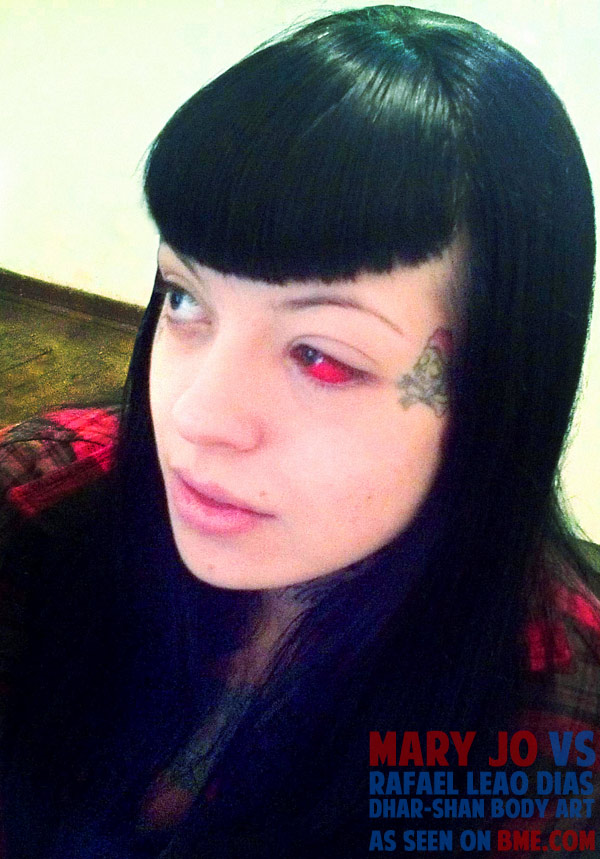
Rafael also posted a video of himself doing the eye tattoo that I posted yesterday. Please, do not treat this video as a “how to”. If anything, note how incredibly differently the first injection and second injection behave — the margin for error in this procedure is extremely slim, and unfortunately the only way to figure it out at present is trial and error because the procedure is still being refined and is still experimental. You can’t sign up for a class in it at the next APP convention. So it’s almost certain that every practitioner that throws their hat into the ring is going to mess up some eyes — over-injection, lumpy eyes, various sorts of damage, aesthetic shortcomings, facial stains, and perhaps even serious injury. Different types of tattoo ink respond very differently (for example, UV ink has responded badly in some people). Again, trial and error. In a perfect world, people would seek out experienced practitioners, and practitioners seeking to add this to their roster would seek out training from those with years of experience. But unfortunately we don’t live in a perfect world. Just remember, if you may a mistake on an eye, it’s not like a piercing or an implant or a normal tattoo — there’s no rewind button. You can’t go back. You can’t go to someone and have it reversed. It’s for life. No going back, whether you get it perfect or whether something goes wrong.
Awright, time to break out the ink syringe!

